Richard arkwright cotton spinning frame Stock Photos and Images
(36)See richard arkwright cotton spinning frame stock video clipsQuick filters:
Richard arkwright cotton spinning frame Stock Photos and Images
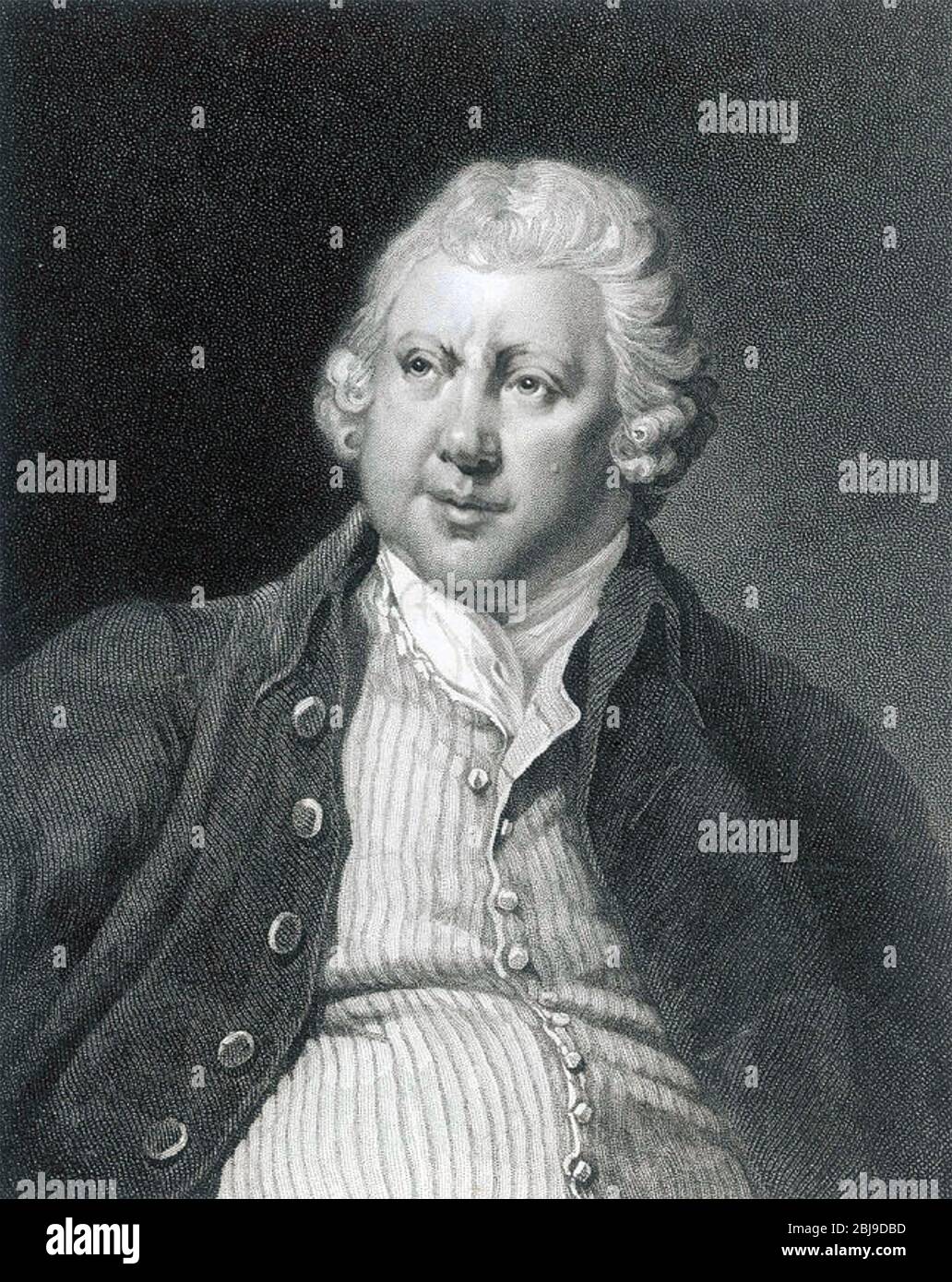 RICHARD ARKWRIGHT (1732-1792) English inventor and entrepreneur in developing cotton spinning and carding. Stock Photohttps://www.alamy.com/image-license-details/?v=1https://www.alamy.com/richard-arkwright-1732-1792-english-inventor-and-entrepreneur-in-developing-cotton-spinning-and-carding-image355479249.html
RICHARD ARKWRIGHT (1732-1792) English inventor and entrepreneur in developing cotton spinning and carding. Stock Photohttps://www.alamy.com/image-license-details/?v=1https://www.alamy.com/richard-arkwright-1732-1792-english-inventor-and-entrepreneur-in-developing-cotton-spinning-and-carding-image355479249.htmlRM2BJ9DBD–RICHARD ARKWRIGHT (1732-1792) English inventor and entrepreneur in developing cotton spinning and carding.
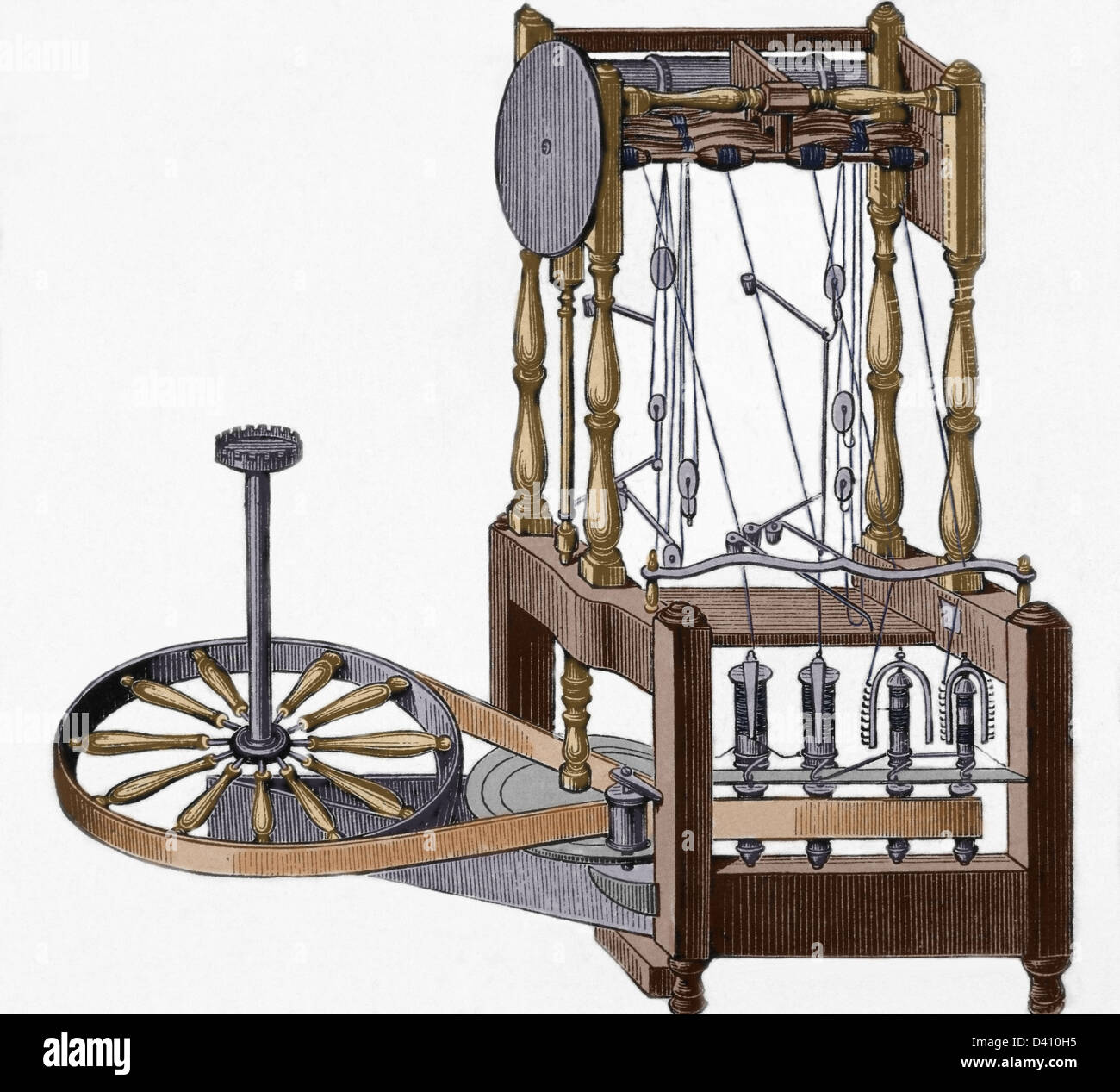 Spinning-frame. Designed in 1767 by Richard Arkwright (1732-1792). Semi-mechanical machine for spinning cotton. Stock Photohttps://www.alamy.com/image-license-details/?v=1https://www.alamy.com/stock-photo-spinning-frame-designed-in-1767-by-richard-arkwright-1732-1792-semi-54112161.html
Spinning-frame. Designed in 1767 by Richard Arkwright (1732-1792). Semi-mechanical machine for spinning cotton. Stock Photohttps://www.alamy.com/image-license-details/?v=1https://www.alamy.com/stock-photo-spinning-frame-designed-in-1767-by-richard-arkwright-1732-1792-semi-54112161.htmlRMD410H5–Spinning-frame. Designed in 1767 by Richard Arkwright (1732-1792). Semi-mechanical machine for spinning cotton.
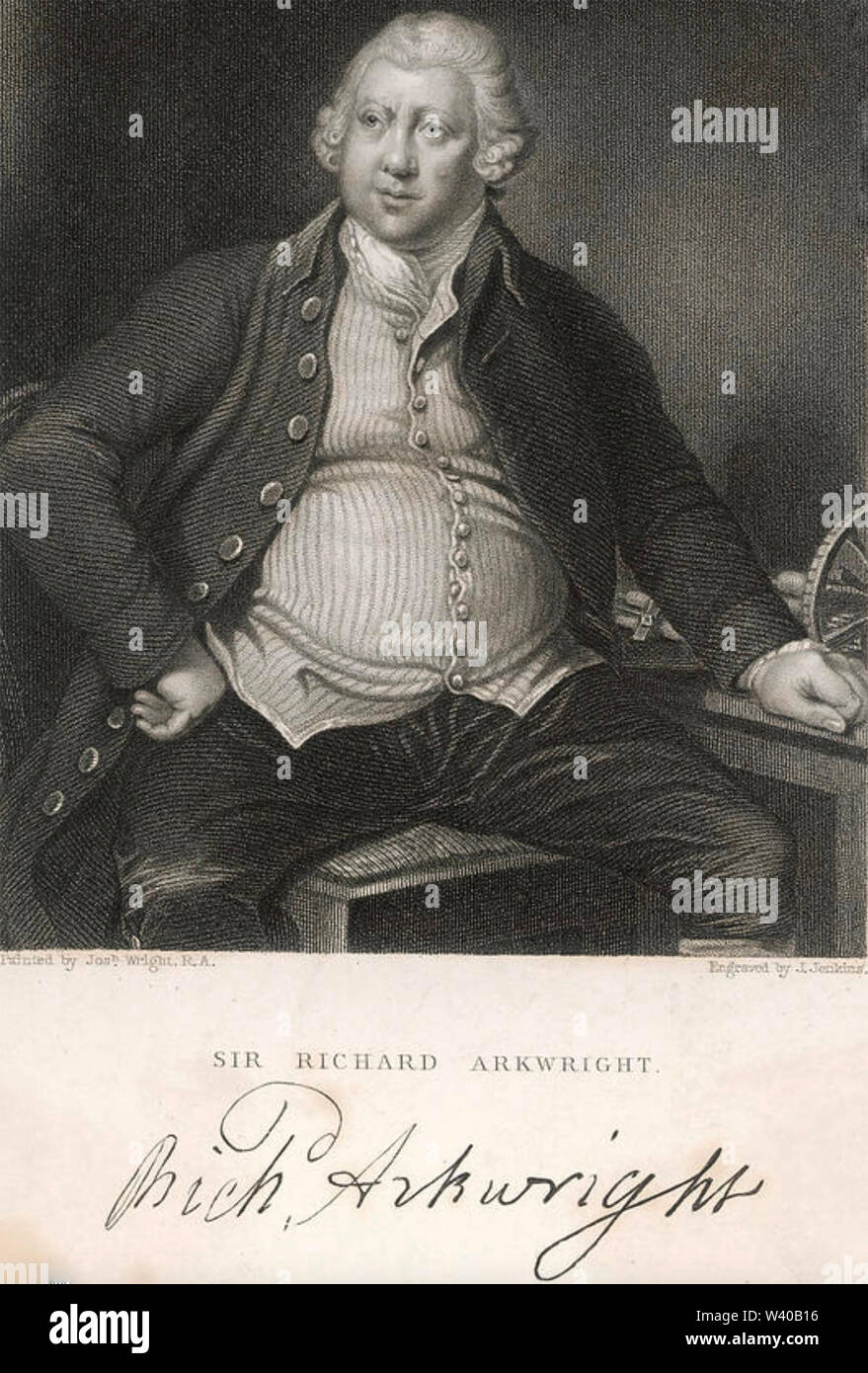 RICHARD ARKWRIGHT (1732-1792) English inventor and entrepreneur Stock Photohttps://www.alamy.com/image-license-details/?v=1https://www.alamy.com/richard-arkwright-1732-1792-english-inventor-and-entrepreneur-image260622802.html
RICHARD ARKWRIGHT (1732-1792) English inventor and entrepreneur Stock Photohttps://www.alamy.com/image-license-details/?v=1https://www.alamy.com/richard-arkwright-1732-1792-english-inventor-and-entrepreneur-image260622802.htmlRMW40B16–RICHARD ARKWRIGHT (1732-1792) English inventor and entrepreneur
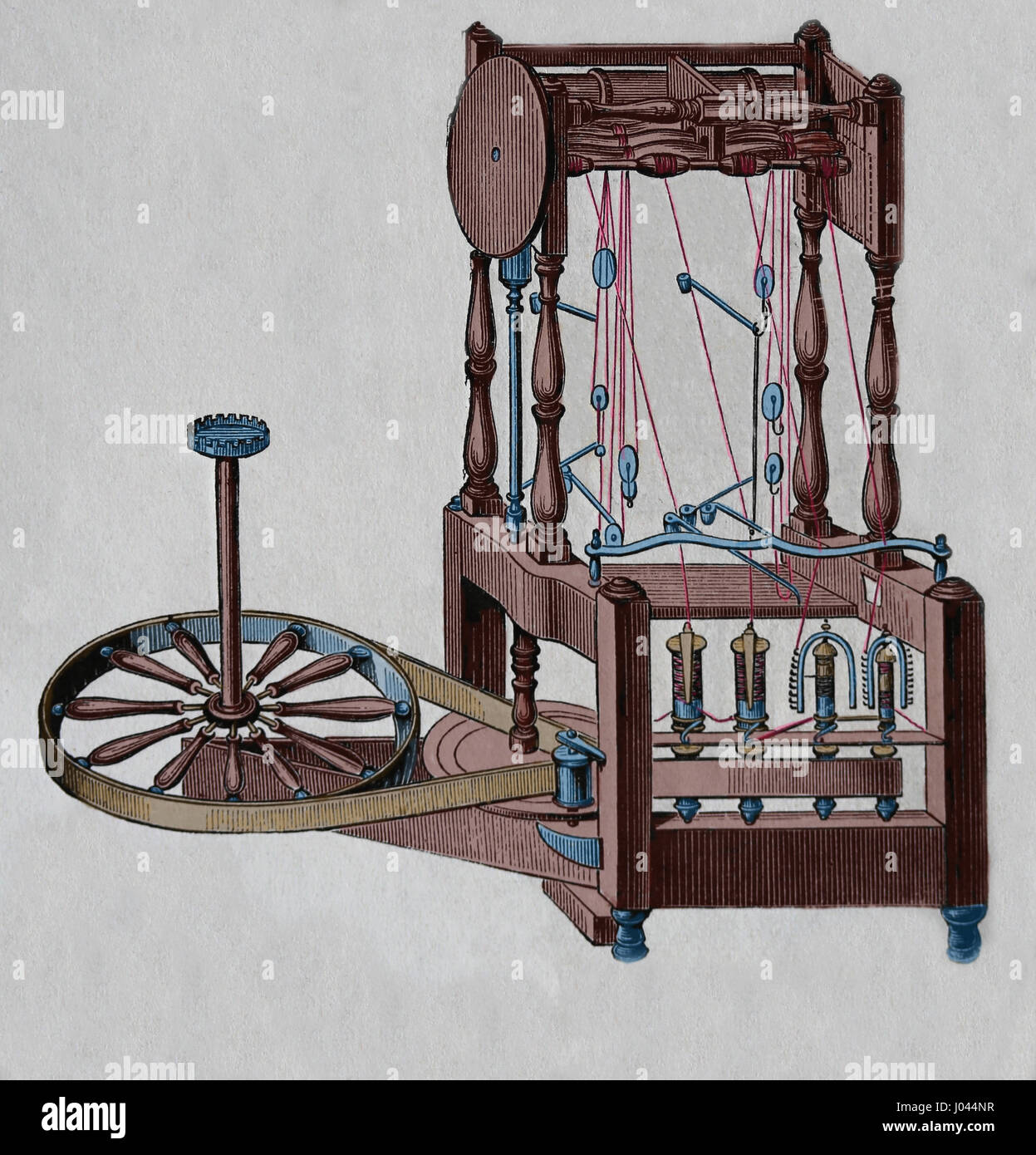 Arkwrights's spinning-frame. Water frame. Designed by Richard Arkwright. Engraving, Nuestro Siglo, 1883. Spanish edition. Stock Photohttps://www.alamy.com/image-license-details/?v=1https://www.alamy.com/stock-photo-arkwrightss-spinning-frame-water-frame-designed-by-richard-arkwright-137774499.html
Arkwrights's spinning-frame. Water frame. Designed by Richard Arkwright. Engraving, Nuestro Siglo, 1883. Spanish edition. Stock Photohttps://www.alamy.com/image-license-details/?v=1https://www.alamy.com/stock-photo-arkwrightss-spinning-frame-water-frame-designed-by-richard-arkwright-137774499.htmlRMJ044NR–Arkwrights's spinning-frame. Water frame. Designed by Richard Arkwright. Engraving, Nuestro Siglo, 1883. Spanish edition.
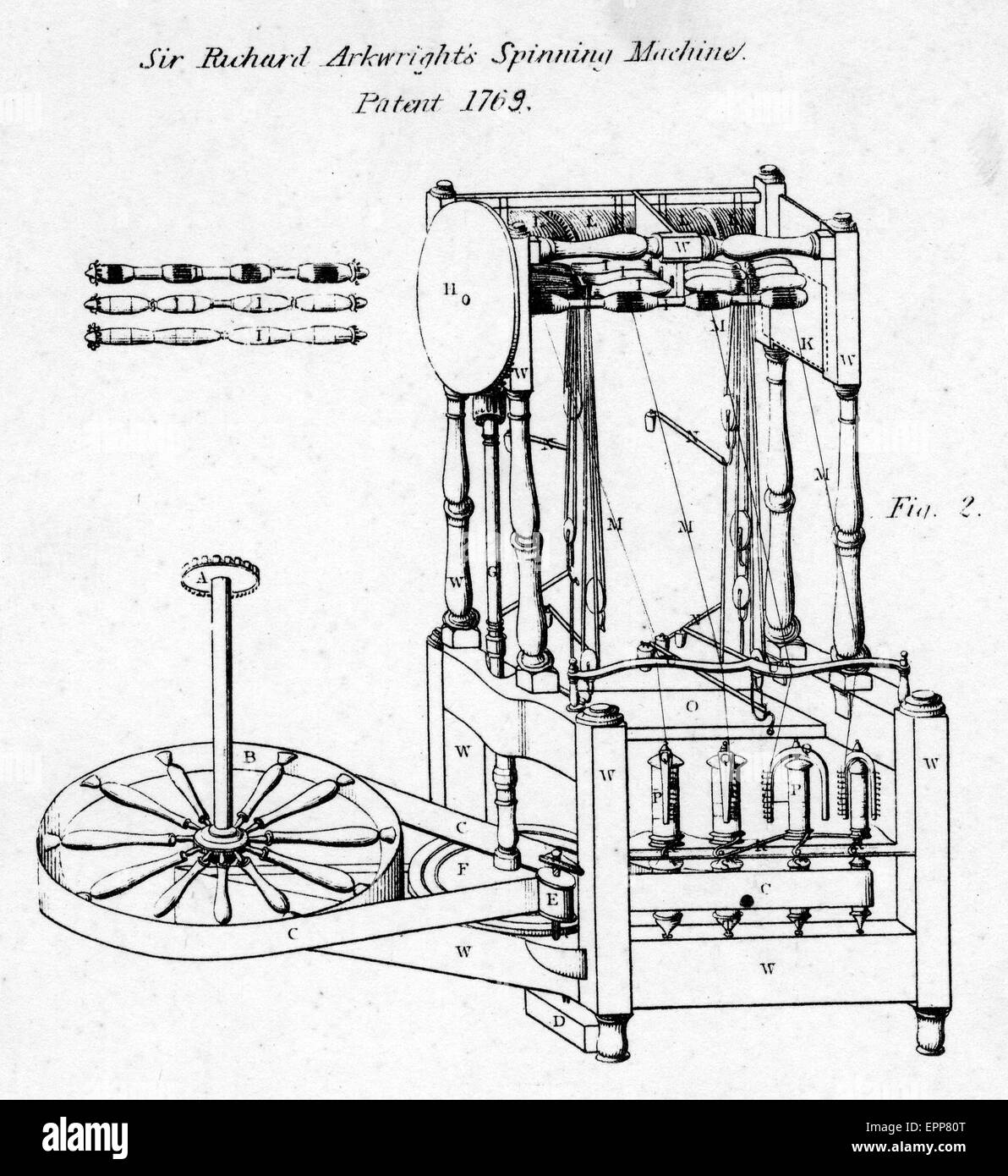 RICHARD ARKWRIGHT (1732-1792) Patent diagram for his Spinning Machine in 1769 Stock Photohttps://www.alamy.com/image-license-details/?v=1https://www.alamy.com/stock-photo-richard-arkwright-1732-1792-patent-diagram-for-his-spinning-machine-82853144.html
RICHARD ARKWRIGHT (1732-1792) Patent diagram for his Spinning Machine in 1769 Stock Photohttps://www.alamy.com/image-license-details/?v=1https://www.alamy.com/stock-photo-richard-arkwright-1732-1792-patent-diagram-for-his-spinning-machine-82853144.htmlRMEPP80T–RICHARD ARKWRIGHT (1732-1792) Patent diagram for his Spinning Machine in 1769
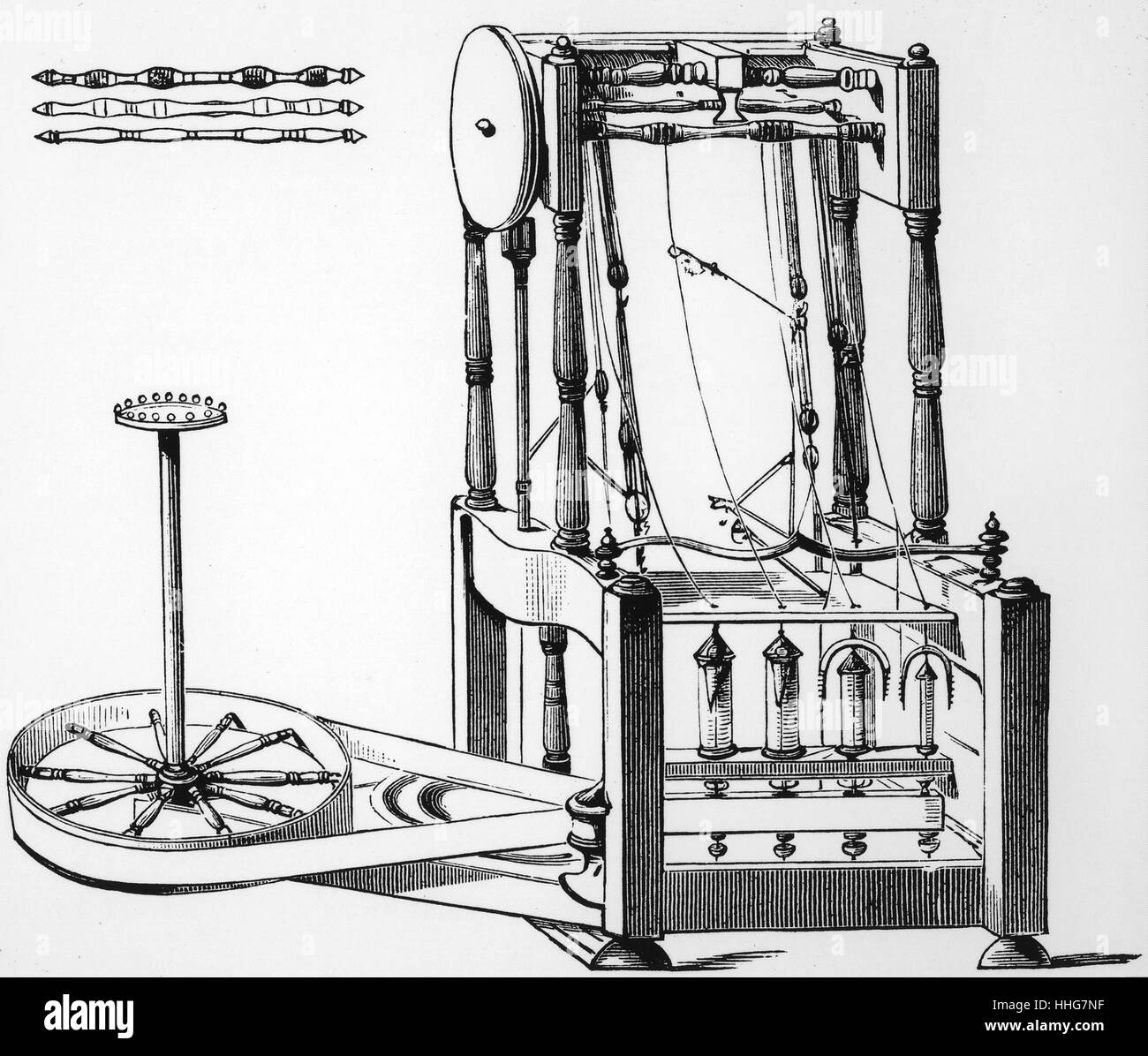 Diagram of Arkwright's water frame; 1878. The water frame is the name given to a water-powered spinning frame which was an easy way to create cotton thread. The first time the machine was used in 1768. It was able to spin 128 threads at a time; which was the easiest and fastest method than ever before. It was developed by Richard Arkwright; who patented the technology in 1767 Stock Photohttps://www.alamy.com/image-license-details/?v=1https://www.alamy.com/stock-photo-diagram-of-arkwrights-water-frame-1878-the-water-frame-is-the-name-131279051.html
Diagram of Arkwright's water frame; 1878. The water frame is the name given to a water-powered spinning frame which was an easy way to create cotton thread. The first time the machine was used in 1768. It was able to spin 128 threads at a time; which was the easiest and fastest method than ever before. It was developed by Richard Arkwright; who patented the technology in 1767 Stock Photohttps://www.alamy.com/image-license-details/?v=1https://www.alamy.com/stock-photo-diagram-of-arkwrights-water-frame-1878-the-water-frame-is-the-name-131279051.htmlRMHHG7NF–Diagram of Arkwright's water frame; 1878. The water frame is the name given to a water-powered spinning frame which was an easy way to create cotton thread. The first time the machine was used in 1768. It was able to spin 128 threads at a time; which was the easiest and fastest method than ever before. It was developed by Richard Arkwright; who patented the technology in 1767
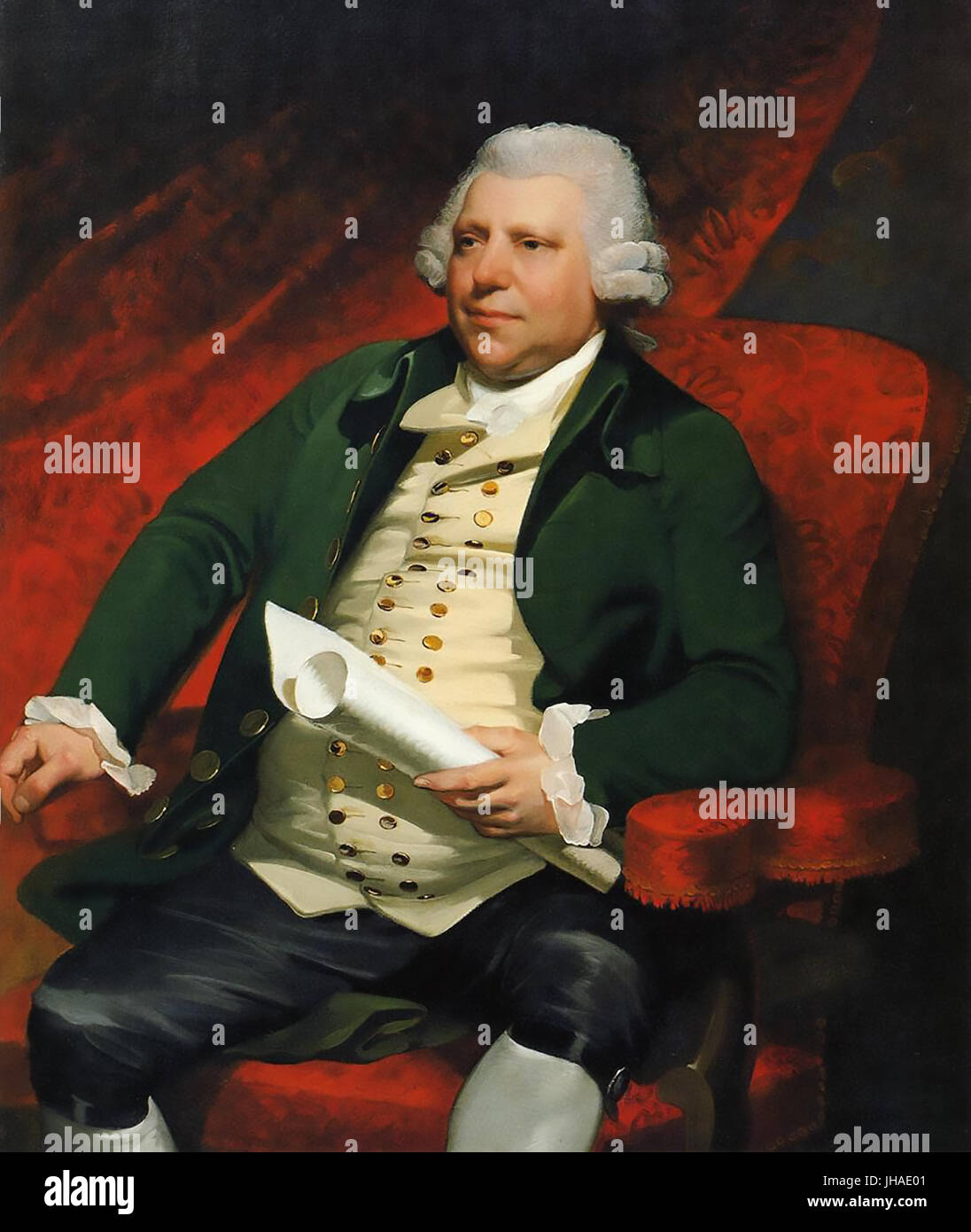 RICHARD ARKWRIGHT (1732-1792) English inventor in 1790 by Mather Brown. Stock Photohttps://www.alamy.com/image-license-details/?v=1https://www.alamy.com/stock-photo-richard-arkwright-1732-1792-english-inventor-in-1790-by-mather-brown-148362593.html
RICHARD ARKWRIGHT (1732-1792) English inventor in 1790 by Mather Brown. Stock Photohttps://www.alamy.com/image-license-details/?v=1https://www.alamy.com/stock-photo-richard-arkwright-1732-1792-english-inventor-in-1790-by-mather-brown-148362593.htmlRMJHAE01–RICHARD ARKWRIGHT (1732-1792) English inventor in 1790 by Mather Brown.
 An old engraving of Arkwright’s water or spinning frame. It is from a Victorian mechanical engineering book of the 1880s. The water frame is a spinning frame that is powered by a water-wheel. Richard Arkwright (1732–1792), who patented it in 1769, designed the machine for making cotton thread. It was first used in 1765 and was able to spin 96 threads at a time, far faster than ever before. In 1770 Arkwright and partners built a water-powered mill in Cromford, Derbyshire, England, UK. It soon employed over 300 people and is often regarded as the first factory of the Industrial Revolution. Stock Photohttps://www.alamy.com/image-license-details/?v=1https://www.alamy.com/an-old-engraving-of-arkwrights-water-or-spinning-frame-it-is-from-a-victorian-mechanical-engineering-book-of-the-1880s-the-water-frame-is-a-spinning-frame-that-is-powered-by-a-water-wheel-richard-arkwright-17321792-who-patented-it-in-1769-designed-the-machine-for-making-cotton-thread-it-was-first-used-in-1765-and-was-able-to-spin-96-threads-at-a-time-far-faster-than-ever-before-in-1770-arkwright-and-partners-built-a-water-powered-mill-in-cromford-derbyshire-england-uk-it-soon-employed-over-300-people-and-is-often-regarded-as-the-first-factory-of-the-industrial-revolution-image388000233.html
An old engraving of Arkwright’s water or spinning frame. It is from a Victorian mechanical engineering book of the 1880s. The water frame is a spinning frame that is powered by a water-wheel. Richard Arkwright (1732–1792), who patented it in 1769, designed the machine for making cotton thread. It was first used in 1765 and was able to spin 96 threads at a time, far faster than ever before. In 1770 Arkwright and partners built a water-powered mill in Cromford, Derbyshire, England, UK. It soon employed over 300 people and is often regarded as the first factory of the Industrial Revolution. Stock Photohttps://www.alamy.com/image-license-details/?v=1https://www.alamy.com/an-old-engraving-of-arkwrights-water-or-spinning-frame-it-is-from-a-victorian-mechanical-engineering-book-of-the-1880s-the-water-frame-is-a-spinning-frame-that-is-powered-by-a-water-wheel-richard-arkwright-17321792-who-patented-it-in-1769-designed-the-machine-for-making-cotton-thread-it-was-first-used-in-1765-and-was-able-to-spin-96-threads-at-a-time-far-faster-than-ever-before-in-1770-arkwright-and-partners-built-a-water-powered-mill-in-cromford-derbyshire-england-uk-it-soon-employed-over-300-people-and-is-often-regarded-as-the-first-factory-of-the-industrial-revolution-image388000233.htmlRM2DF6X75–An old engraving of Arkwright’s water or spinning frame. It is from a Victorian mechanical engineering book of the 1880s. The water frame is a spinning frame that is powered by a water-wheel. Richard Arkwright (1732–1792), who patented it in 1769, designed the machine for making cotton thread. It was first used in 1765 and was able to spin 96 threads at a time, far faster than ever before. In 1770 Arkwright and partners built a water-powered mill in Cromford, Derbyshire, England, UK. It soon employed over 300 people and is often regarded as the first factory of the Industrial Revolution.
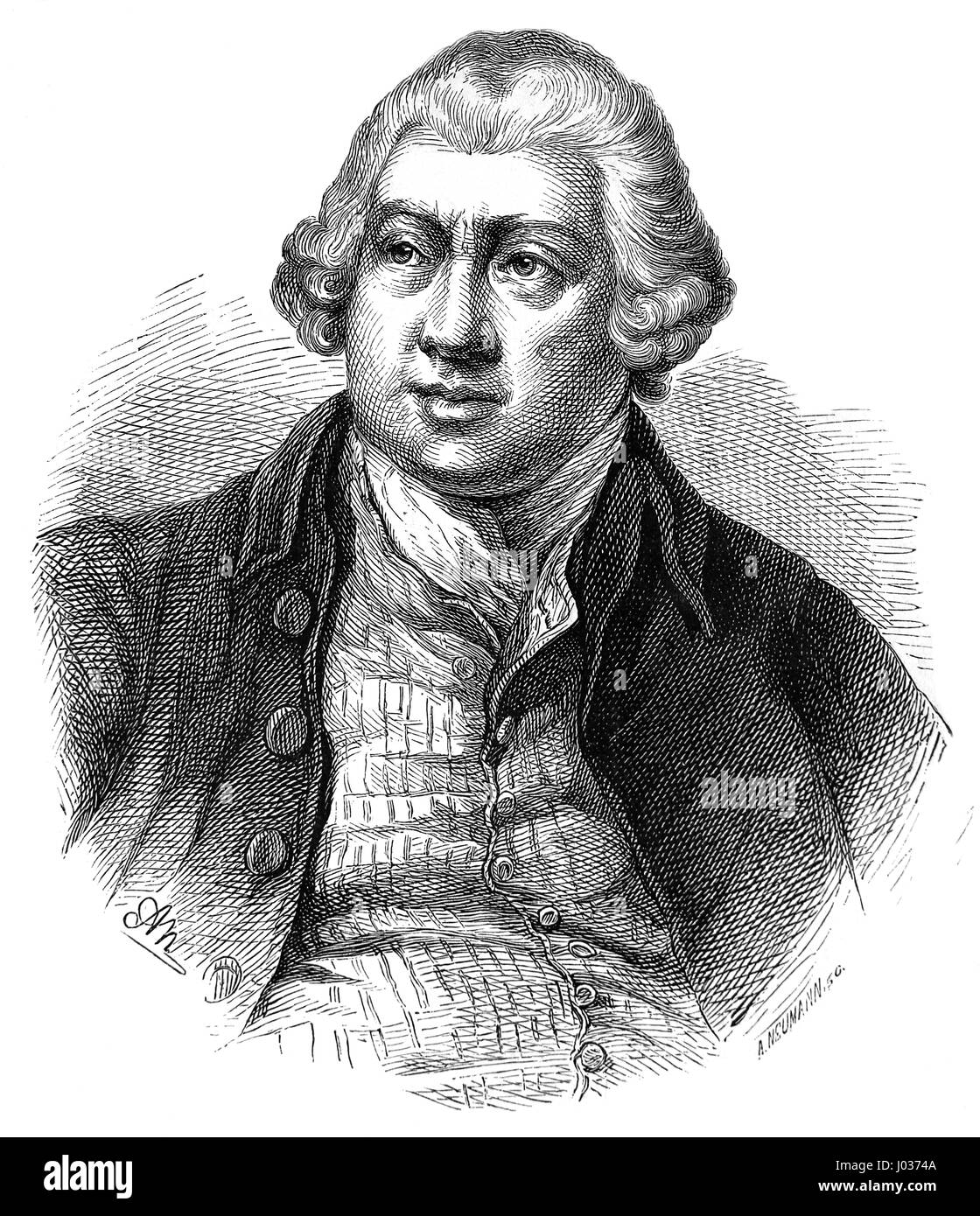 Richard Arkwright (1732-1792). Inventing the spinning frame. Engraving. Nuestro Siglo, 1883. Spanish edition. Stock Photohttps://www.alamy.com/image-license-details/?v=1https://www.alamy.com/stock-photo-richard-arkwright-1732-1792-inventing-the-spinning-frame-engraving-137754410.html
Richard Arkwright (1732-1792). Inventing the spinning frame. Engraving. Nuestro Siglo, 1883. Spanish edition. Stock Photohttps://www.alamy.com/image-license-details/?v=1https://www.alamy.com/stock-photo-richard-arkwright-1732-1792-inventing-the-spinning-frame-engraving-137754410.htmlRMJ0374A–Richard Arkwright (1732-1792). Inventing the spinning frame. Engraving. Nuestro Siglo, 1883. Spanish edition.
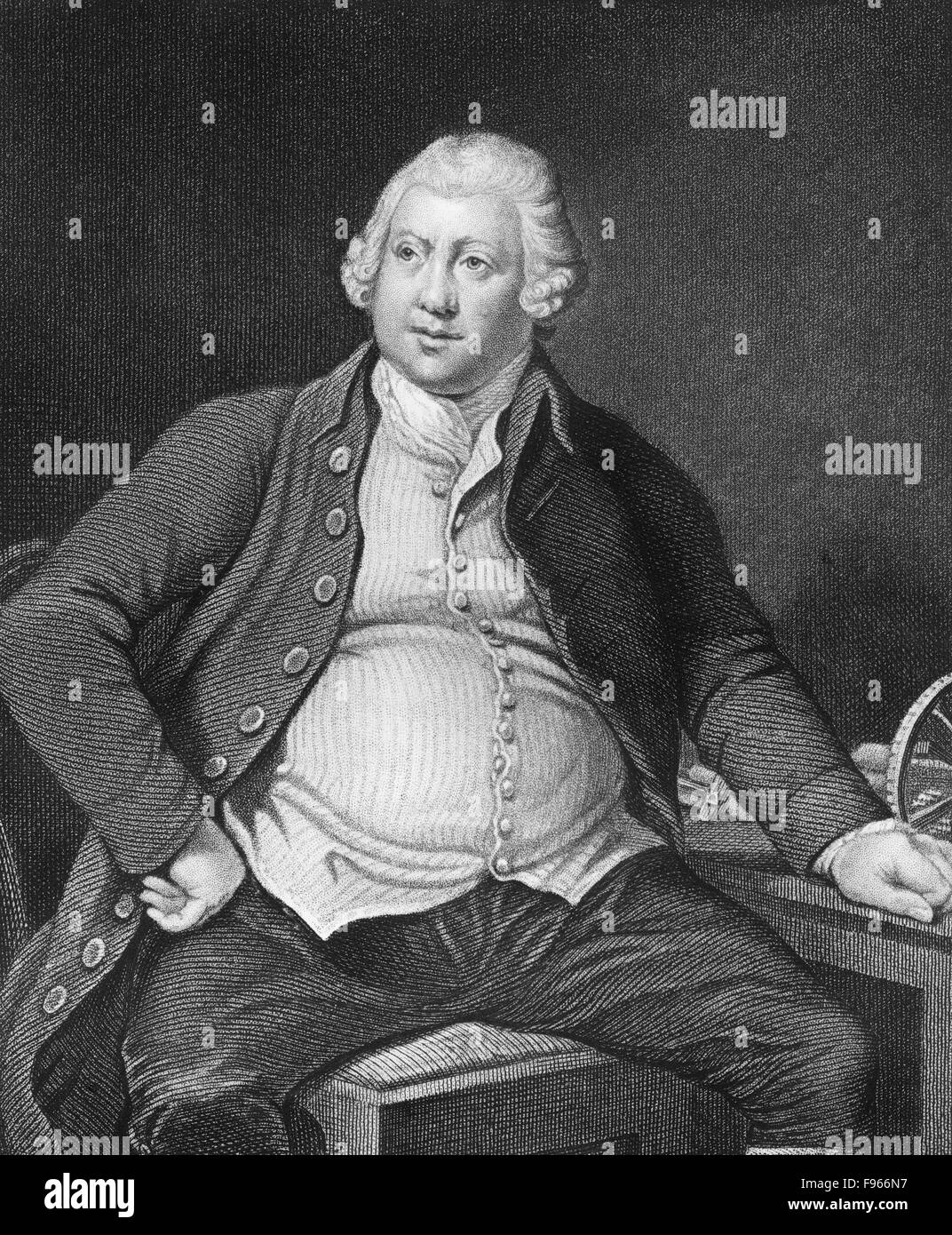 Sir Richard Arkwright, 1732-1792, a leading entrepreneur during the early Industrial Revolution, Stock Photohttps://www.alamy.com/image-license-details/?v=1https://www.alamy.com/stock-photo-sir-richard-arkwright-1732-1792-a-leading-entrepreneur-during-the-91720755.html
Sir Richard Arkwright, 1732-1792, a leading entrepreneur during the early Industrial Revolution, Stock Photohttps://www.alamy.com/image-license-details/?v=1https://www.alamy.com/stock-photo-sir-richard-arkwright-1732-1792-a-leading-entrepreneur-during-the-91720755.htmlRMF966N7–Sir Richard Arkwright, 1732-1792, a leading entrepreneur during the early Industrial Revolution,
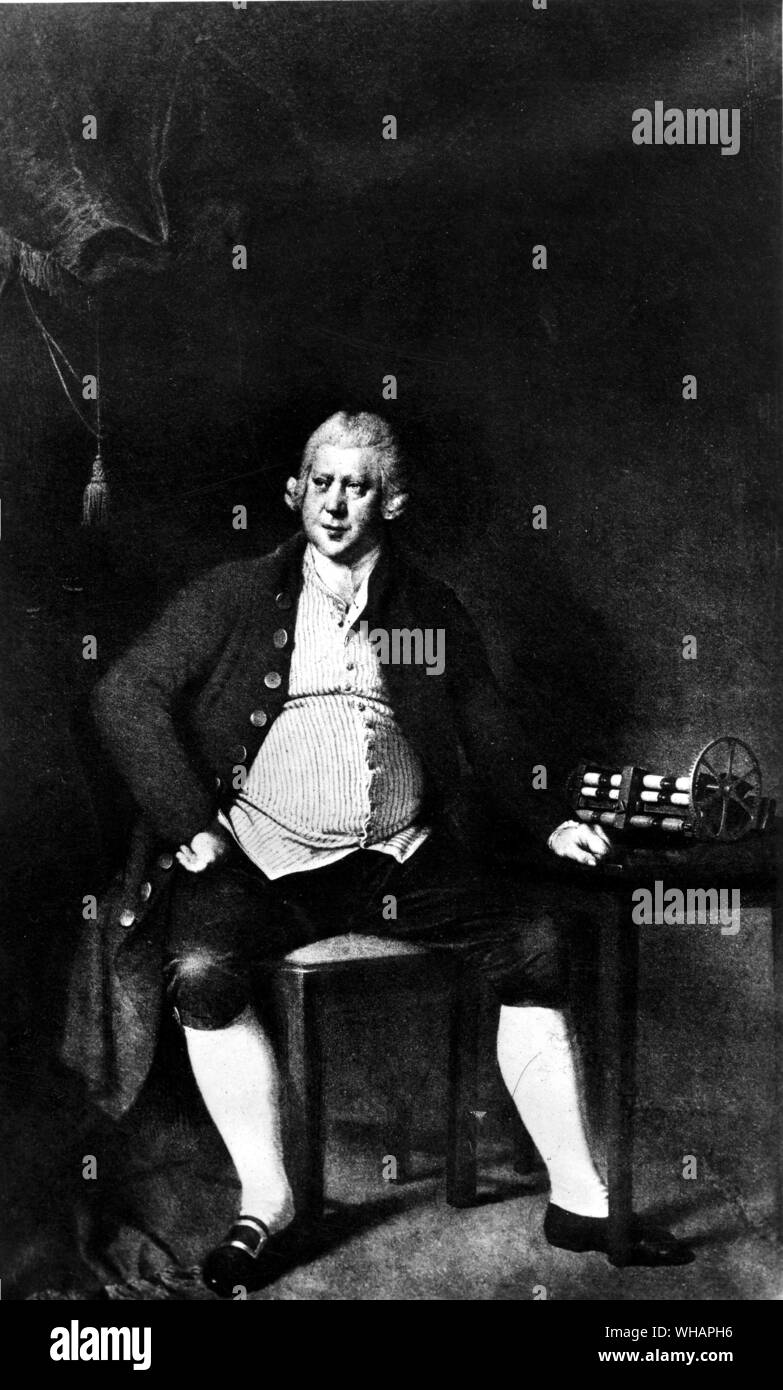 Sir Richard Arkwright (b. the last of 13 children December 23, 1732, d. August 3, 1792) was an Englishman credited with the Spinning Frame — later renamed the Water Frame following the transition to water power. The spinning frame – loosely based on the Spinning Jenny of James Hargreaves – was developed in 1769, and the world's first water-powered cotton mill was built in 1771 at Cromford, Derbyshire, (now one of the Derwent Valley Mills) creating one of the catalysts for the Industrial Revolution. He was knighted in 1786.. . Stock Photohttps://www.alamy.com/image-license-details/?v=1https://www.alamy.com/sir-richard-arkwright-b-the-last-of-13-children-december-23-1732-d-august-3-1792-was-an-englishman-credited-with-the-spinning-frame-later-renamed-the-water-frame-following-the-transition-to-water-power-the-spinning-frame-loosely-based-on-the-spinning-jenny-of-james-hargreaves-was-developed-in-1769-and-the-worlds-first-water-powered-cotton-mill-was-built-in-1771-at-cromford-derbyshire-now-one-of-the-derwent-valley-mills-creating-one-of-the-catalysts-for-the-industrial-revolution-he-was-knighted-in-1786-image268841922.html
Sir Richard Arkwright (b. the last of 13 children December 23, 1732, d. August 3, 1792) was an Englishman credited with the Spinning Frame — later renamed the Water Frame following the transition to water power. The spinning frame – loosely based on the Spinning Jenny of James Hargreaves – was developed in 1769, and the world's first water-powered cotton mill was built in 1771 at Cromford, Derbyshire, (now one of the Derwent Valley Mills) creating one of the catalysts for the Industrial Revolution. He was knighted in 1786.. . Stock Photohttps://www.alamy.com/image-license-details/?v=1https://www.alamy.com/sir-richard-arkwright-b-the-last-of-13-children-december-23-1732-d-august-3-1792-was-an-englishman-credited-with-the-spinning-frame-later-renamed-the-water-frame-following-the-transition-to-water-power-the-spinning-frame-loosely-based-on-the-spinning-jenny-of-james-hargreaves-was-developed-in-1769-and-the-worlds-first-water-powered-cotton-mill-was-built-in-1771-at-cromford-derbyshire-now-one-of-the-derwent-valley-mills-creating-one-of-the-catalysts-for-the-industrial-revolution-he-was-knighted-in-1786-image268841922.htmlRMWHAPH6–Sir Richard Arkwright (b. the last of 13 children December 23, 1732, d. August 3, 1792) was an Englishman credited with the Spinning Frame — later renamed the Water Frame following the transition to water power. The spinning frame – loosely based on the Spinning Jenny of James Hargreaves – was developed in 1769, and the world's first water-powered cotton mill was built in 1771 at Cromford, Derbyshire, (now one of the Derwent Valley Mills) creating one of the catalysts for the Industrial Revolution. He was knighted in 1786.. .
 Richard Arkwright (1732-1792), English inventor and industrialist, born at Preston in Lancashire. Inventor in 1769 of the spinning frame (water frame). In 1771, in partnership with Jedediah Strutt, he built the first water-powered cotton mill at Cromford, Derbyshire. His innovations contributed significantly to the Industrial Revolution and he died one of the richest men in England. Engraving after the portrait by Joseph Wright of Derby. From 'The Gallery of Portraits', Vol V, by Charles Knight (London, 1835). Stock Photohttps://www.alamy.com/image-license-details/?v=1https://www.alamy.com/richard-arkwright-1732-1792-english-inventor-and-industrialist-born-at-preston-in-lancashire-inventor-in-1769-of-the-spinning-frame-water-frame-in-1771-in-partnership-with-jedediah-strutt-he-built-the-first-water-powered-cotton-mill-at-cromford-derbyshire-his-innovations-contributed-significantly-to-the-industrial-revolution-and-he-died-one-of-the-richest-men-in-england-engraving-after-the-portrait-by-joseph-wright-of-derby-from-the-gallery-of-portraits-vol-v-by-charles-knight-london-1835-image257301445.html
Richard Arkwright (1732-1792), English inventor and industrialist, born at Preston in Lancashire. Inventor in 1769 of the spinning frame (water frame). In 1771, in partnership with Jedediah Strutt, he built the first water-powered cotton mill at Cromford, Derbyshire. His innovations contributed significantly to the Industrial Revolution and he died one of the richest men in England. Engraving after the portrait by Joseph Wright of Derby. From 'The Gallery of Portraits', Vol V, by Charles Knight (London, 1835). Stock Photohttps://www.alamy.com/image-license-details/?v=1https://www.alamy.com/richard-arkwright-1732-1792-english-inventor-and-industrialist-born-at-preston-in-lancashire-inventor-in-1769-of-the-spinning-frame-water-frame-in-1771-in-partnership-with-jedediah-strutt-he-built-the-first-water-powered-cotton-mill-at-cromford-derbyshire-his-innovations-contributed-significantly-to-the-industrial-revolution-and-he-died-one-of-the-richest-men-in-england-engraving-after-the-portrait-by-joseph-wright-of-derby-from-the-gallery-of-portraits-vol-v-by-charles-knight-london-1835-image257301445.htmlRMTXH2H9–Richard Arkwright (1732-1792), English inventor and industrialist, born at Preston in Lancashire. Inventor in 1769 of the spinning frame (water frame). In 1771, in partnership with Jedediah Strutt, he built the first water-powered cotton mill at Cromford, Derbyshire. His innovations contributed significantly to the Industrial Revolution and he died one of the richest men in England. Engraving after the portrait by Joseph Wright of Derby. From 'The Gallery of Portraits', Vol V, by Charles Knight (London, 1835).
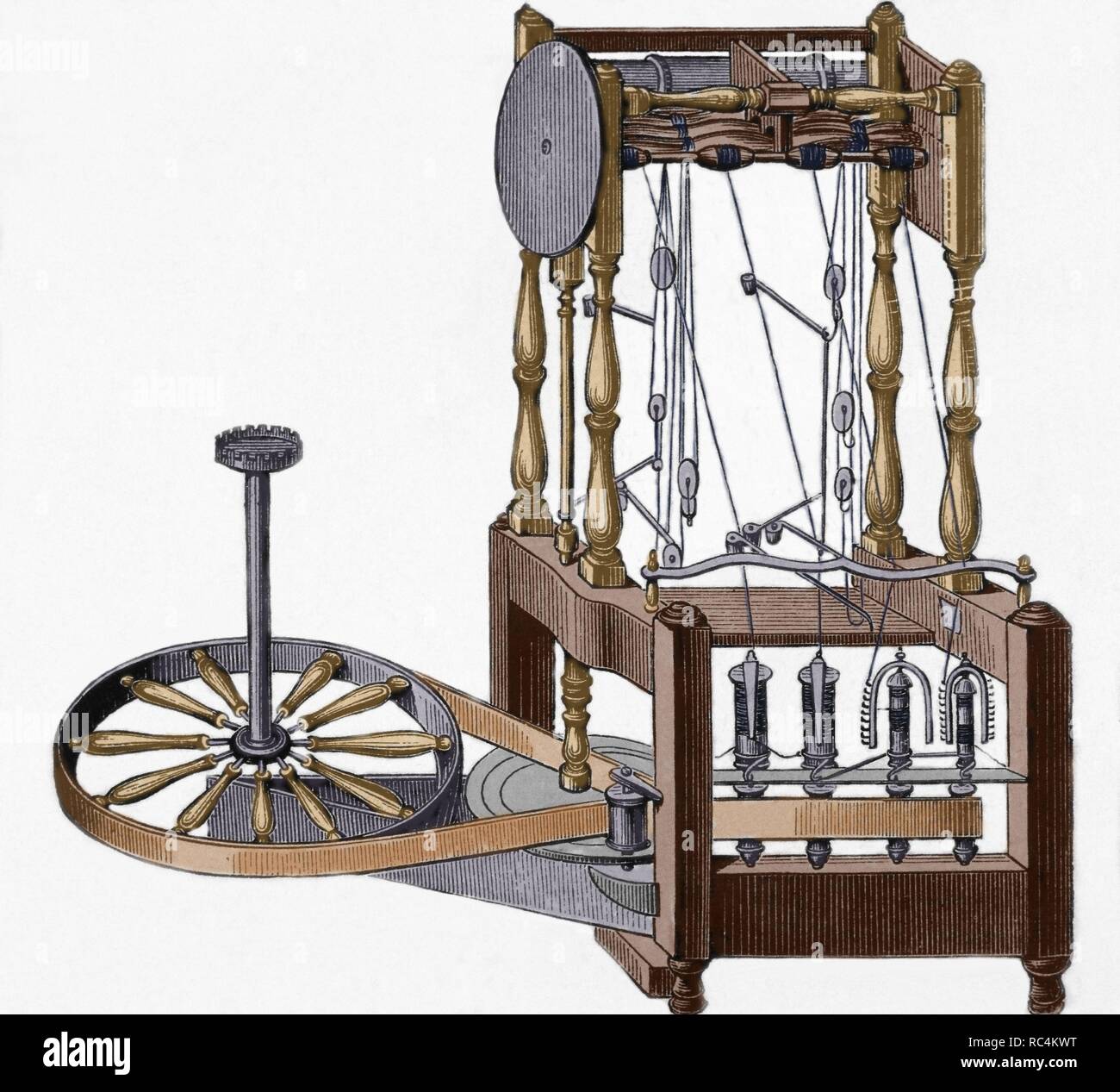 Spinning-frame. Designed in 1767 by Richard Arkwright (1732-1792). Semi-mechanical machine for spinning cotton driven by water power. 18th century. Colored engraving. Stock Photohttps://www.alamy.com/image-license-details/?v=1https://www.alamy.com/spinning-frame-designed-in-1767-by-richard-arkwright-1732-1792-semi-mechanical-machine-for-spinning-cotton-driven-by-water-power-18th-century-colored-engraving-image231214084.html
Spinning-frame. Designed in 1767 by Richard Arkwright (1732-1792). Semi-mechanical machine for spinning cotton driven by water power. 18th century. Colored engraving. Stock Photohttps://www.alamy.com/image-license-details/?v=1https://www.alamy.com/spinning-frame-designed-in-1767-by-richard-arkwright-1732-1792-semi-mechanical-machine-for-spinning-cotton-driven-by-water-power-18th-century-colored-engraving-image231214084.htmlRMRC4KWT–Spinning-frame. Designed in 1767 by Richard Arkwright (1732-1792). Semi-mechanical machine for spinning cotton driven by water power. 18th century. Colored engraving.
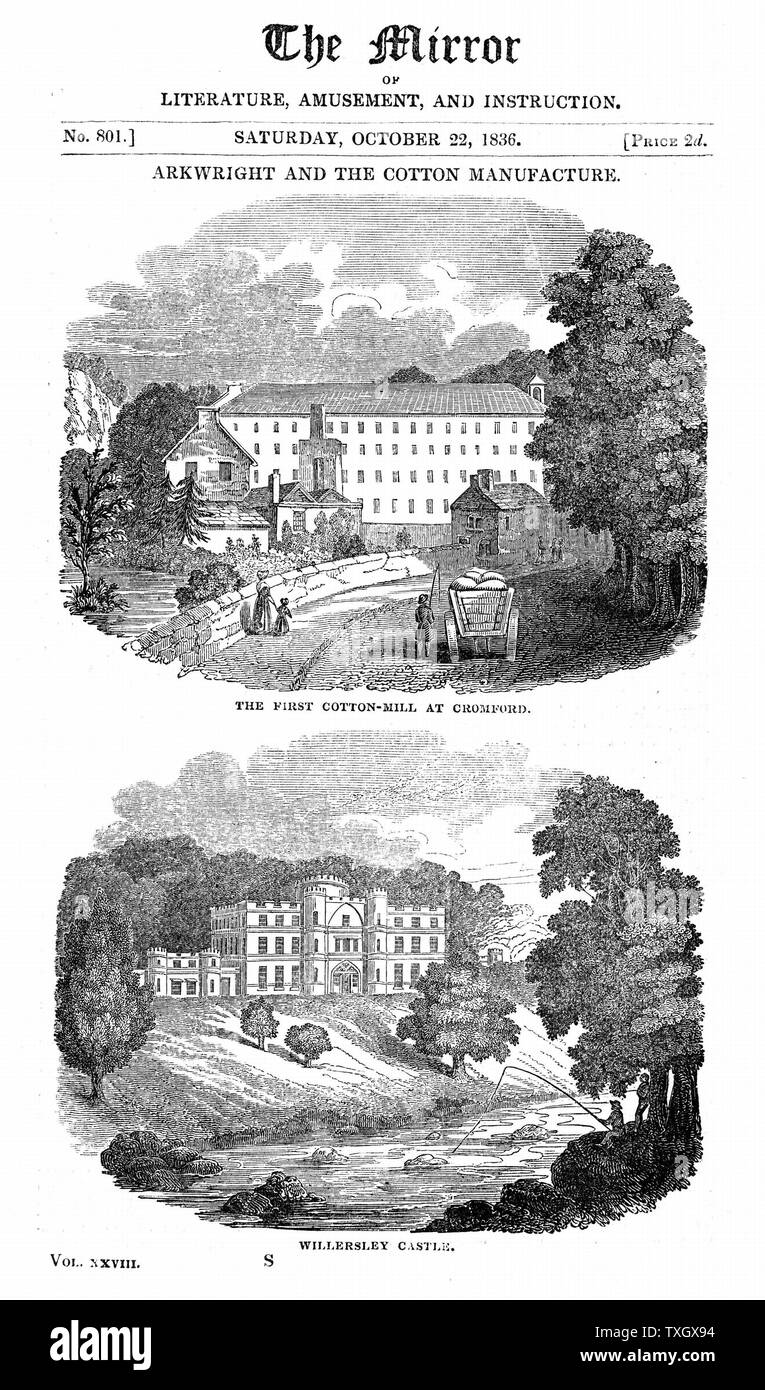 Richard Arkwright (1732-1792) British industrialist and inventor: Water-powered spinning frame. Top: Cotton mill at Cromford, Wirksworth, Derbyshire which Arkwright fitted with his water frame. Bottom: Willersley Castle, the house Arkwright built for himself. 1836 Woodcut Stock Photohttps://www.alamy.com/image-license-details/?v=1https://www.alamy.com/richard-arkwright-1732-1792-british-industrialist-and-inventor-water-powered-spinning-frame-top-cotton-mill-at-cromford-wirksworth-derbyshire-which-arkwright-fitted-with-his-water-frame-bottom-willersley-castle-the-house-arkwright-built-for-himself-1836-woodcut-image257298080.html
Richard Arkwright (1732-1792) British industrialist and inventor: Water-powered spinning frame. Top: Cotton mill at Cromford, Wirksworth, Derbyshire which Arkwright fitted with his water frame. Bottom: Willersley Castle, the house Arkwright built for himself. 1836 Woodcut Stock Photohttps://www.alamy.com/image-license-details/?v=1https://www.alamy.com/richard-arkwright-1732-1792-british-industrialist-and-inventor-water-powered-spinning-frame-top-cotton-mill-at-cromford-wirksworth-derbyshire-which-arkwright-fitted-with-his-water-frame-bottom-willersley-castle-the-house-arkwright-built-for-himself-1836-woodcut-image257298080.htmlRMTXGX94–Richard Arkwright (1732-1792) British industrialist and inventor: Water-powered spinning frame. Top: Cotton mill at Cromford, Wirksworth, Derbyshire which Arkwright fitted with his water frame. Bottom: Willersley Castle, the house Arkwright built for himself. 1836 Woodcut
 SIR RICHARD ARKWRIGHT 1732 to 1792 English industrialist inventor mechanical spinning frame water cotton mill Cromford, Derbysh Stock Photohttps://www.alamy.com/image-license-details/?v=1https://www.alamy.com/stock-photo-sir-richard-arkwright-1732-to-1792-english-industrialist-inventor-15264538.html
SIR RICHARD ARKWRIGHT 1732 to 1792 English industrialist inventor mechanical spinning frame water cotton mill Cromford, Derbysh Stock Photohttps://www.alamy.com/image-license-details/?v=1https://www.alamy.com/stock-photo-sir-richard-arkwright-1732-to-1792-english-industrialist-inventor-15264538.htmlRMAMH4RR–SIR RICHARD ARKWRIGHT 1732 to 1792 English industrialist inventor mechanical spinning frame water cotton mill Cromford, Derbysh
 Arkwright House Preston Stock Photohttps://www.alamy.com/image-license-details/?v=1https://www.alamy.com/stock-photo-arkwright-house-preston-16393557.html
Arkwright House Preston Stock Photohttps://www.alamy.com/image-license-details/?v=1https://www.alamy.com/stock-photo-arkwright-house-preston-16393557.htmlRMATW50P–Arkwright House Preston
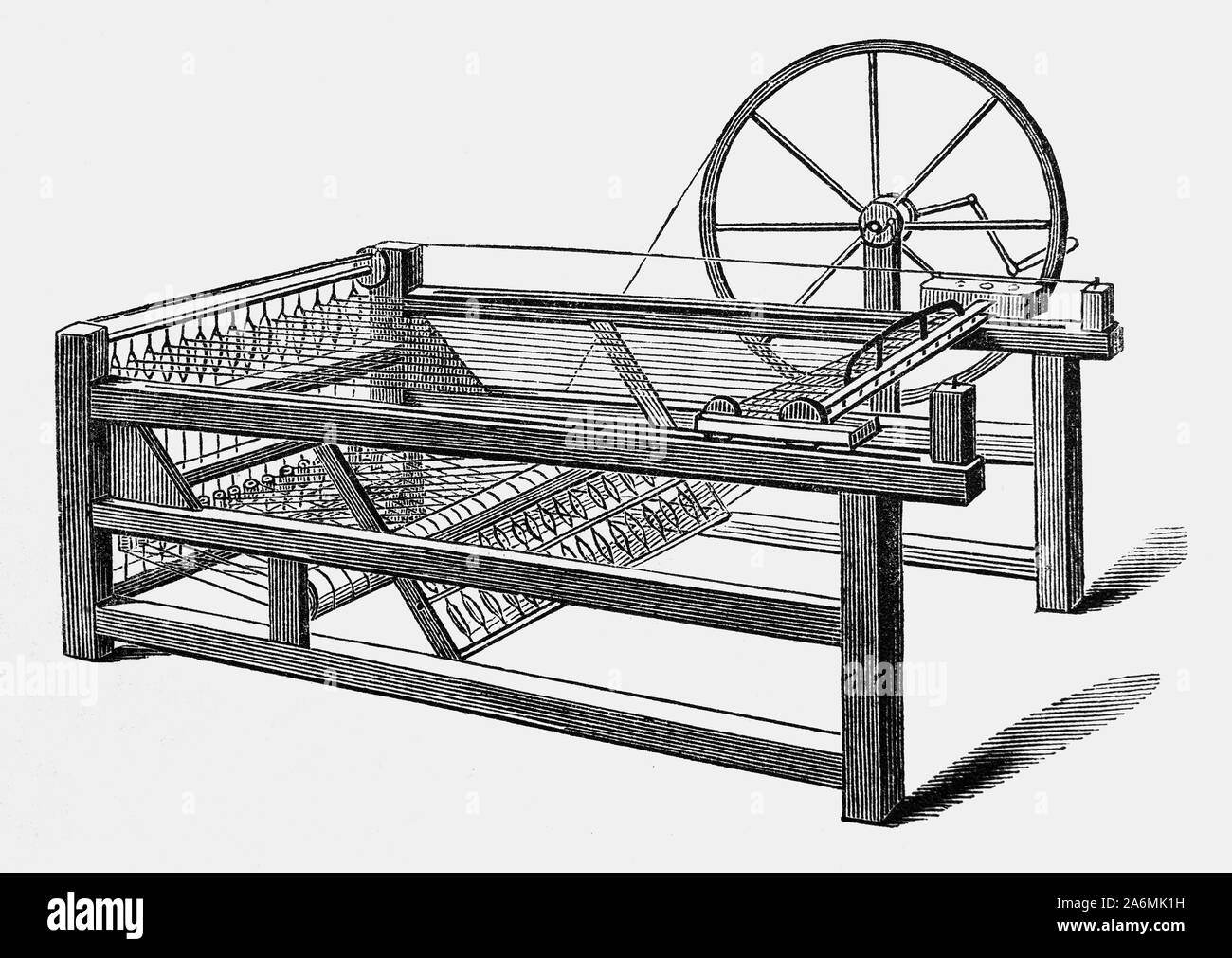 The spinning jenny is a multi-spindle spinning frame, invented in 1764 by James Hargreaves in Lancashire, England. It was one of the key developments in the industrialization of weaving during the early Industrial Revolution. The device reduced the amount of work needed to produce cloth, with a worker able to work eight or more spools at once. This grew to 120 as technology advanced. The yarn produced was not very strong until Richard Arkwright invented the water-powered water frame, which produced yarn harder and stronger than that of the initial spinning jenny starting the factory system. Stock Photohttps://www.alamy.com/image-license-details/?v=1https://www.alamy.com/the-spinning-jenny-is-a-multi-spindle-spinning-frame-invented-in-1764-by-james-hargreaves-in-lancashire-england-it-was-one-of-the-key-developments-in-the-industrialization-of-weaving-during-the-early-industrial-revolution-the-device-reduced-the-amount-of-work-needed-to-produce-cloth-with-a-worker-able-to-work-eight-or-more-spools-at-once-this-grew-to-120-as-technology-advanced-the-yarn-produced-was-not-very-strong-until-richard-arkwright-invented-the-water-powered-water-frame-which-produced-yarn-harder-and-stronger-than-that-of-the-initial-spinning-jenny-starting-the-factory-system-image331138909.html
The spinning jenny is a multi-spindle spinning frame, invented in 1764 by James Hargreaves in Lancashire, England. It was one of the key developments in the industrialization of weaving during the early Industrial Revolution. The device reduced the amount of work needed to produce cloth, with a worker able to work eight or more spools at once. This grew to 120 as technology advanced. The yarn produced was not very strong until Richard Arkwright invented the water-powered water frame, which produced yarn harder and stronger than that of the initial spinning jenny starting the factory system. Stock Photohttps://www.alamy.com/image-license-details/?v=1https://www.alamy.com/the-spinning-jenny-is-a-multi-spindle-spinning-frame-invented-in-1764-by-james-hargreaves-in-lancashire-england-it-was-one-of-the-key-developments-in-the-industrialization-of-weaving-during-the-early-industrial-revolution-the-device-reduced-the-amount-of-work-needed-to-produce-cloth-with-a-worker-able-to-work-eight-or-more-spools-at-once-this-grew-to-120-as-technology-advanced-the-yarn-produced-was-not-very-strong-until-richard-arkwright-invented-the-water-powered-water-frame-which-produced-yarn-harder-and-stronger-than-that-of-the-initial-spinning-jenny-starting-the-factory-system-image331138909.htmlRM2A6MK1H–The spinning jenny is a multi-spindle spinning frame, invented in 1764 by James Hargreaves in Lancashire, England. It was one of the key developments in the industrialization of weaving during the early Industrial Revolution. The device reduced the amount of work needed to produce cloth, with a worker able to work eight or more spools at once. This grew to 120 as technology advanced. The yarn produced was not very strong until Richard Arkwright invented the water-powered water frame, which produced yarn harder and stronger than that of the initial spinning jenny starting the factory system.
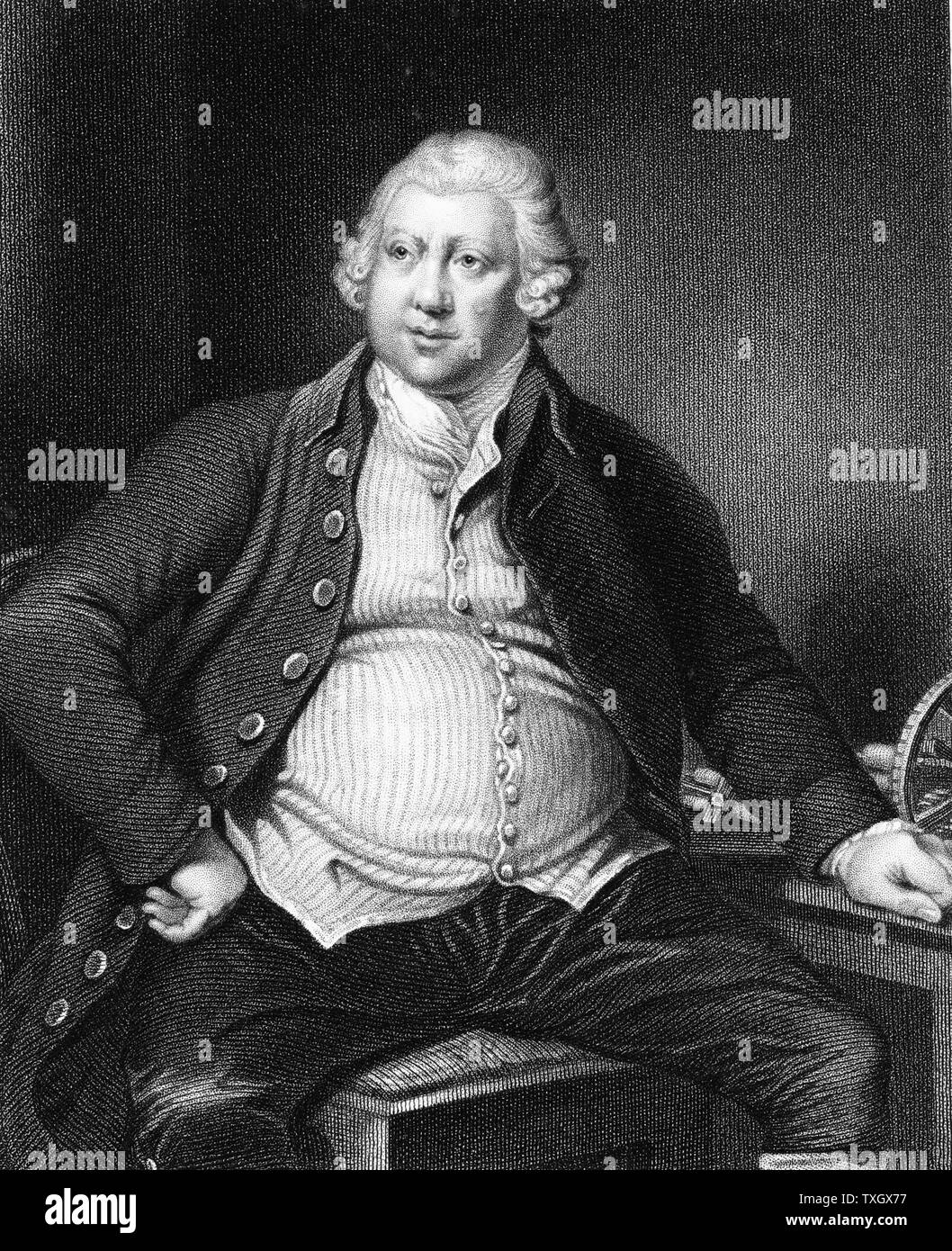 Richard Arkwright (1732-1792) British industrialist and inventor: Water-powered spinning frame. Engraving after portrait by Joseph Wright of Derby Stock Photohttps://www.alamy.com/image-license-details/?v=1https://www.alamy.com/richard-arkwright-1732-1792-british-industrialist-and-inventor-water-powered-spinning-frame-engraving-after-portrait-by-joseph-wright-of-derby-image257298027.html
Richard Arkwright (1732-1792) British industrialist and inventor: Water-powered spinning frame. Engraving after portrait by Joseph Wright of Derby Stock Photohttps://www.alamy.com/image-license-details/?v=1https://www.alamy.com/richard-arkwright-1732-1792-british-industrialist-and-inventor-water-powered-spinning-frame-engraving-after-portrait-by-joseph-wright-of-derby-image257298027.htmlRMTXGX77–Richard Arkwright (1732-1792) British industrialist and inventor: Water-powered spinning frame. Engraving after portrait by Joseph Wright of Derby
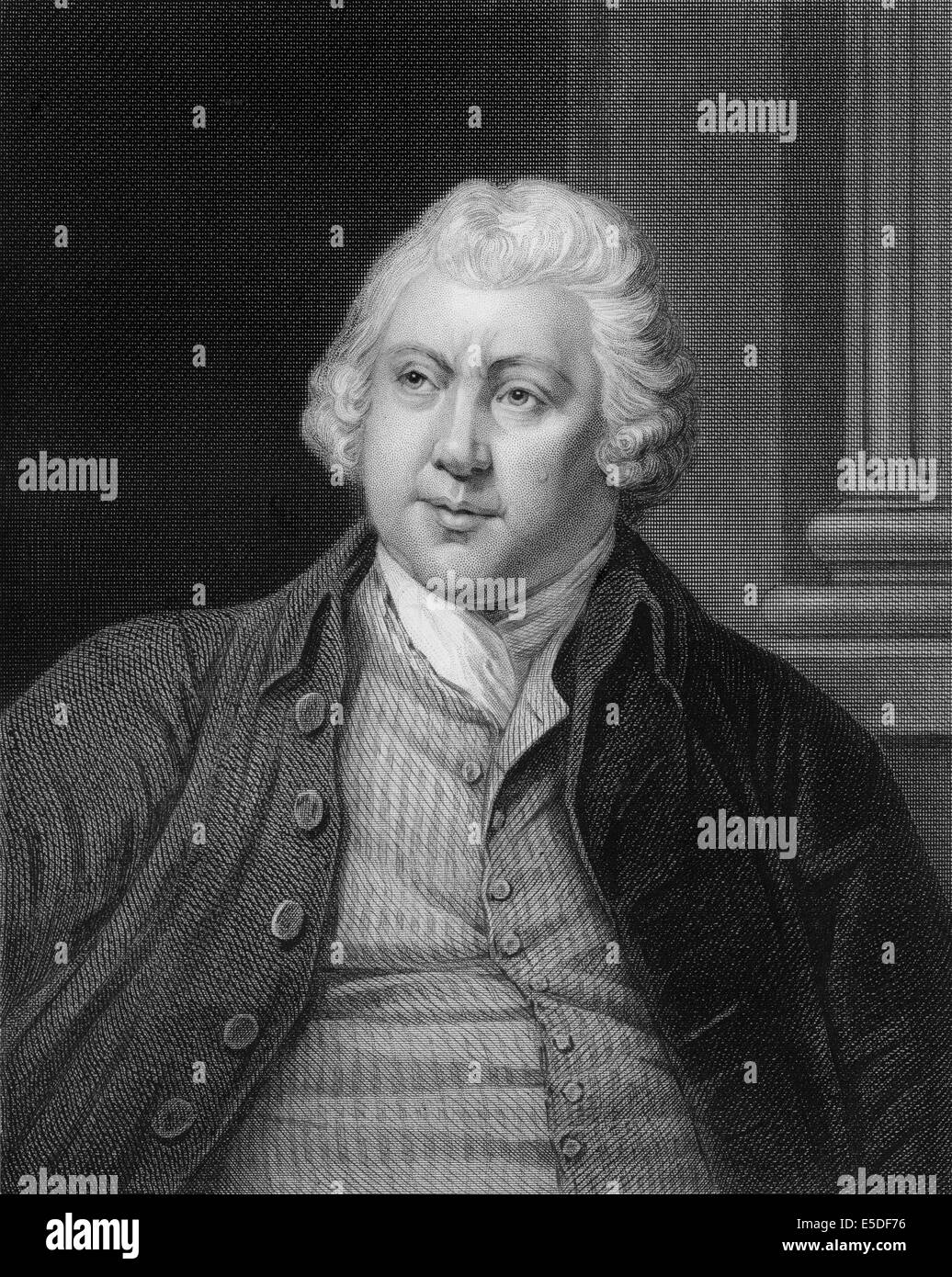 Steel engraving, c. 1860, Sir Richard Arkwright, 1732-1792, a leading entrepreneur during the early Industrial Revolution Stock Photohttps://www.alamy.com/image-license-details/?v=1https://www.alamy.com/stock-photo-steel-engraving-c-1860-sir-richard-arkwright-1732-1792-a-leading-entrepreneur-72212090.html
Steel engraving, c. 1860, Sir Richard Arkwright, 1732-1792, a leading entrepreneur during the early Industrial Revolution Stock Photohttps://www.alamy.com/image-license-details/?v=1https://www.alamy.com/stock-photo-steel-engraving-c-1860-sir-richard-arkwright-1732-1792-a-leading-entrepreneur-72212090.htmlRME5DF76–Steel engraving, c. 1860, Sir Richard Arkwright, 1732-1792, a leading entrepreneur during the early Industrial Revolution
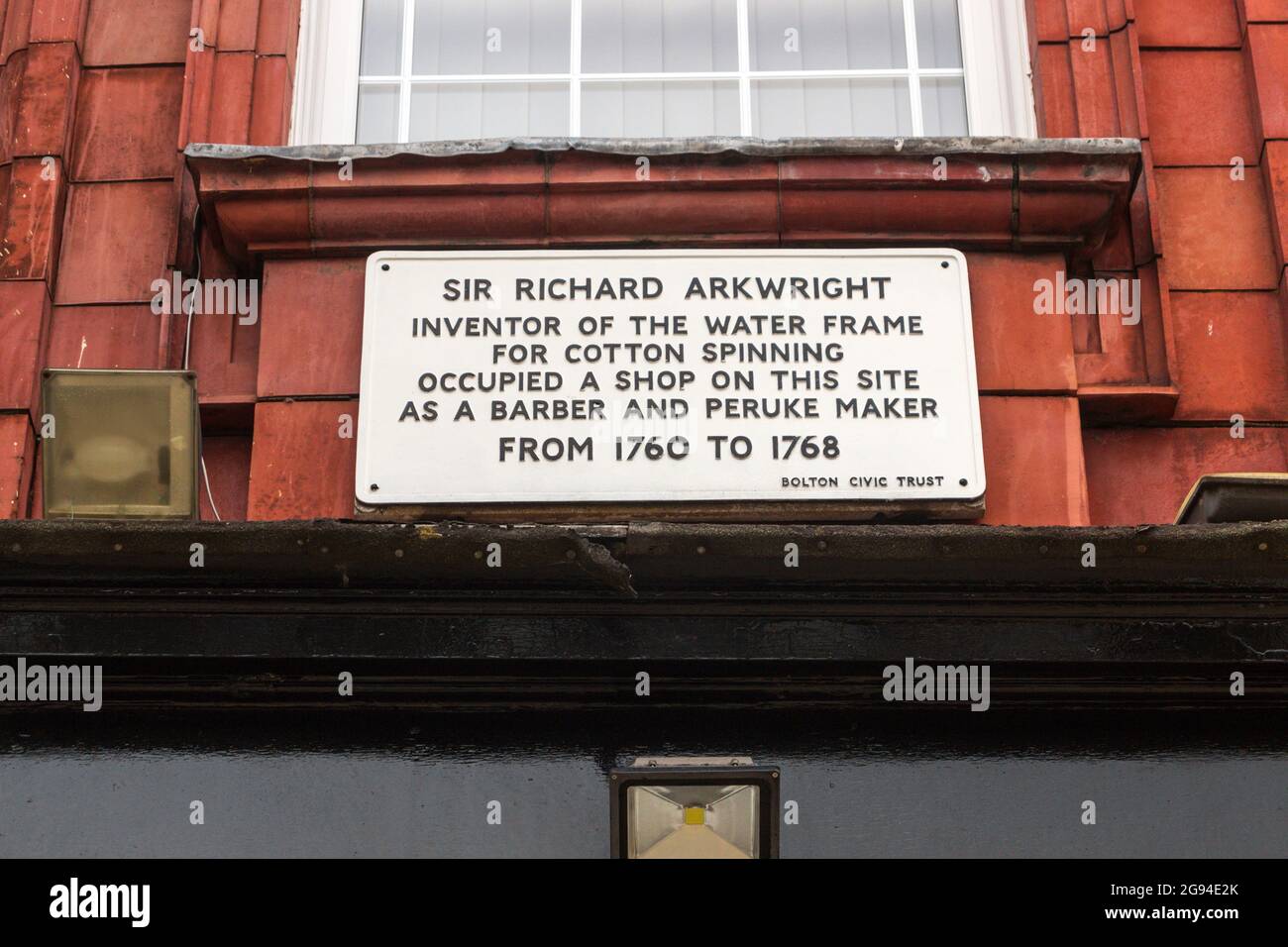 Sir Richard Arkwright plaque. Churchgate, Bolton, Greater Manchester. Stock Photohttps://www.alamy.com/image-license-details/?v=1https://www.alamy.com/sir-richard-arkwright-plaque-churchgate-bolton-greater-manchester-image435889963.html
Sir Richard Arkwright plaque. Churchgate, Bolton, Greater Manchester. Stock Photohttps://www.alamy.com/image-license-details/?v=1https://www.alamy.com/sir-richard-arkwright-plaque-churchgate-bolton-greater-manchester-image435889963.htmlRM2G94E2K–Sir Richard Arkwright plaque. Churchgate, Bolton, Greater Manchester.
 Cromford cotton spinning water powered mills, Sir Richard Arkwright’s first mill complex, birthplace of the factory system, and a UNESCO World Heritag Stock Photohttps://www.alamy.com/image-license-details/?v=1https://www.alamy.com/cromford-cotton-spinning-water-powered-mills-sir-richard-arkwrights-first-mill-complex-birthplace-of-the-factory-system-and-a-unesco-world-heritag-image340981984.html
Cromford cotton spinning water powered mills, Sir Richard Arkwright’s first mill complex, birthplace of the factory system, and a UNESCO World Heritag Stock Photohttps://www.alamy.com/image-license-details/?v=1https://www.alamy.com/cromford-cotton-spinning-water-powered-mills-sir-richard-arkwrights-first-mill-complex-birthplace-of-the-factory-system-and-a-unesco-world-heritag-image340981984.htmlRF2APN200–Cromford cotton spinning water powered mills, Sir Richard Arkwright’s first mill complex, birthplace of the factory system, and a UNESCO World Heritag
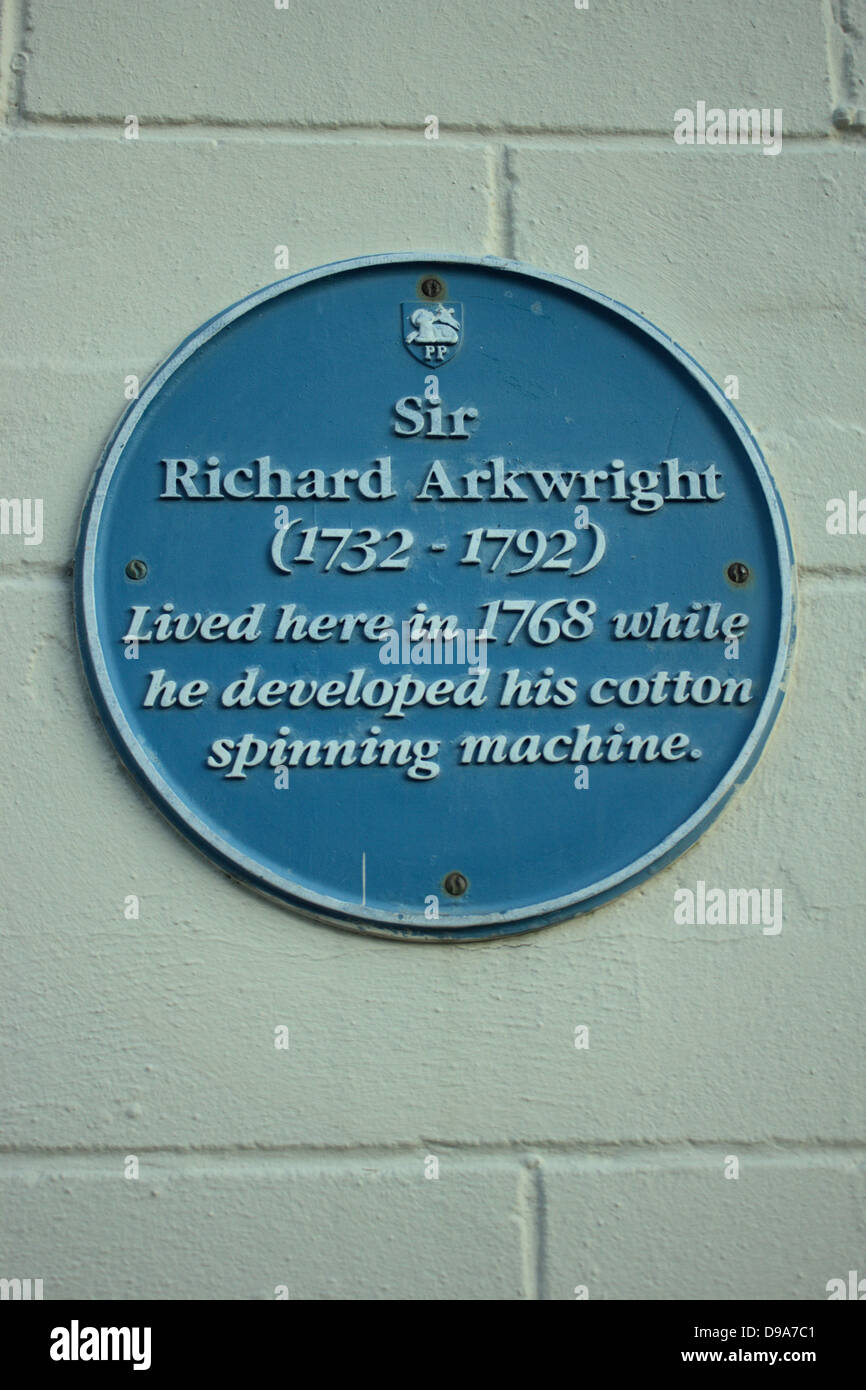 Sir Richard Arkwright Blue Plaque. Stock Photohttps://www.alamy.com/image-license-details/?v=1https://www.alamy.com/stock-photo-sir-richard-arkwright-blue-plaque-57388353.html
Sir Richard Arkwright Blue Plaque. Stock Photohttps://www.alamy.com/image-license-details/?v=1https://www.alamy.com/stock-photo-sir-richard-arkwright-blue-plaque-57388353.htmlRMD9A7C1–Sir Richard Arkwright Blue Plaque.
 . The story of textiles; a bird's-eye view of the history of the beginning and the growth of the industry by which mankind is clothed. s given the movementby Richard Arkwright, who has been called the father ofthe factory system. It was to his executive and financialability, quite as much as to the inventive genius he dis-played in the improvement of the spinning frame, that thiswas due. The first practical cotton mill in the world waserected by him in 1769 at Nottingham and was turned byhorses. One had already been built in 1764 by JamesHargreaves, who invented the spinning jenny, but it wasn Stock Photohttps://www.alamy.com/image-license-details/?v=1https://www.alamy.com/the-story-of-textiles-a-birds-eye-view-of-the-history-of-the-beginning-and-the-growth-of-the-industry-by-which-mankind-is-clothed-s-given-the-movementby-richard-arkwright-who-has-been-called-the-father-ofthe-factory-system-it-was-to-his-executive-and-financialability-quite-as-much-as-to-the-inventive-genius-he-dis-played-in-the-improvement-of-the-spinning-frame-that-thiswas-due-the-first-practical-cotton-mill-in-the-world-waserected-by-him-in-1769-at-nottingham-and-was-turned-byhorses-one-had-already-been-built-in-1764-by-jameshargreaves-who-invented-the-spinning-jenny-but-it-wasn-image370311113.html
. The story of textiles; a bird's-eye view of the history of the beginning and the growth of the industry by which mankind is clothed. s given the movementby Richard Arkwright, who has been called the father ofthe factory system. It was to his executive and financialability, quite as much as to the inventive genius he dis-played in the improvement of the spinning frame, that thiswas due. The first practical cotton mill in the world waserected by him in 1769 at Nottingham and was turned byhorses. One had already been built in 1764 by JamesHargreaves, who invented the spinning jenny, but it wasn Stock Photohttps://www.alamy.com/image-license-details/?v=1https://www.alamy.com/the-story-of-textiles-a-birds-eye-view-of-the-history-of-the-beginning-and-the-growth-of-the-industry-by-which-mankind-is-clothed-s-given-the-movementby-richard-arkwright-who-has-been-called-the-father-ofthe-factory-system-it-was-to-his-executive-and-financialability-quite-as-much-as-to-the-inventive-genius-he-dis-played-in-the-improvement-of-the-spinning-frame-that-thiswas-due-the-first-practical-cotton-mill-in-the-world-waserected-by-him-in-1769-at-nottingham-and-was-turned-byhorses-one-had-already-been-built-in-1764-by-jameshargreaves-who-invented-the-spinning-jenny-but-it-wasn-image370311113.htmlRM2CED3GW–. The story of textiles; a bird's-eye view of the history of the beginning and the growth of the industry by which mankind is clothed. s given the movementby Richard Arkwright, who has been called the father ofthe factory system. It was to his executive and financialability, quite as much as to the inventive genius he dis-played in the improvement of the spinning frame, that thiswas due. The first practical cotton mill in the world waserected by him in 1769 at Nottingham and was turned byhorses. One had already been built in 1764 by JamesHargreaves, who invented the spinning jenny, but it wasn
 Blue plaque marking the occupancy by Arkwright in Adam Street, London Stock Photohttps://www.alamy.com/image-license-details/?v=1https://www.alamy.com/blue-plaque-marking-the-occupancy-by-arkwright-in-adam-street-london-image468287646.html
Blue plaque marking the occupancy by Arkwright in Adam Street, London Stock Photohttps://www.alamy.com/image-license-details/?v=1https://www.alamy.com/blue-plaque-marking-the-occupancy-by-arkwright-in-adam-street-london-image468287646.htmlRM2J5T9JP–Blue plaque marking the occupancy by Arkwright in Adam Street, London
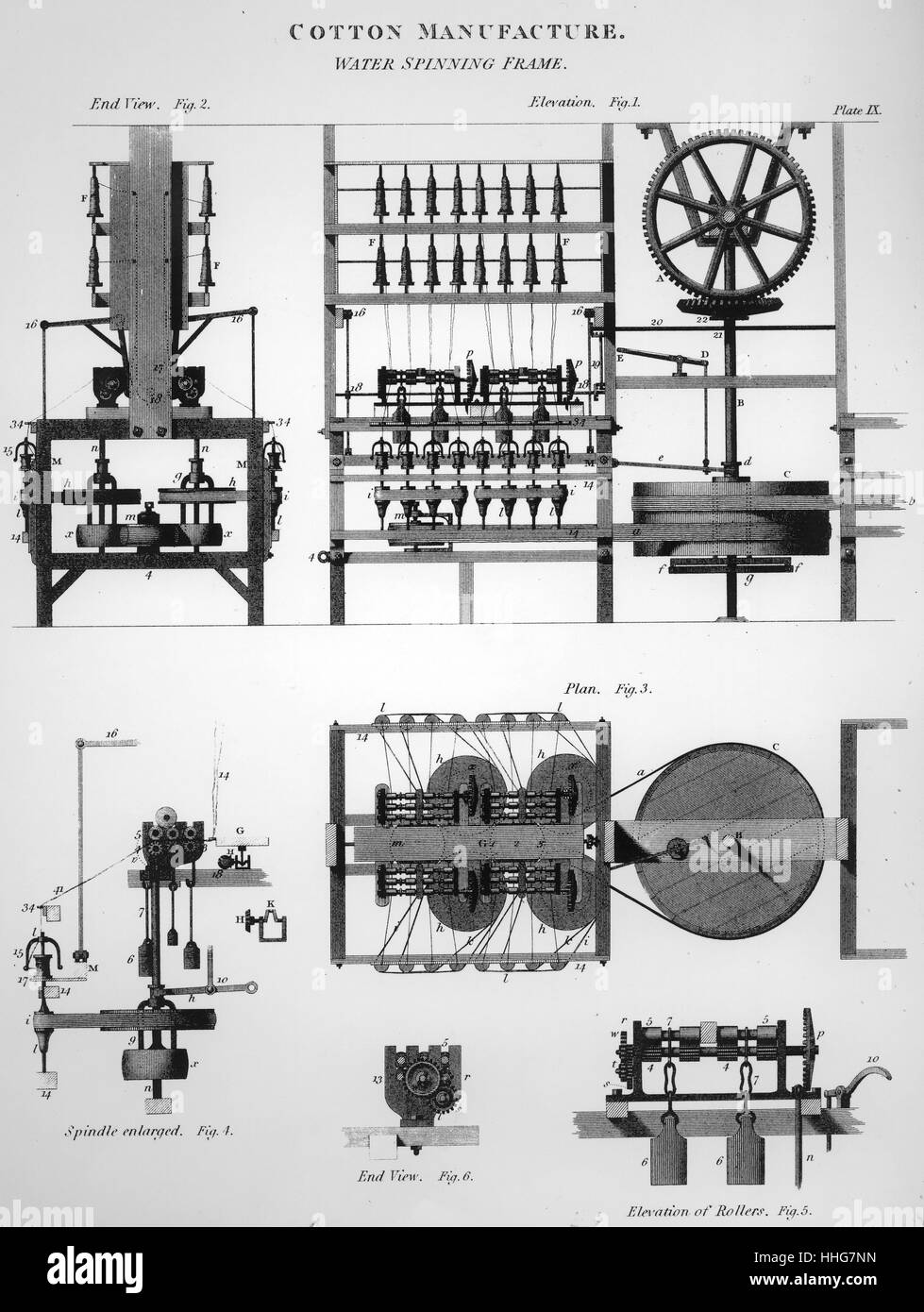 Diagram of Arkwright's water frame; 1878. The water frame is the name given to a water-powered spinning frame which was an easy way to create cotton thread. The first time the machine was used in 1768. It was able to spin 128 threads at a time; which was the easiest and fastest method than ever before. It was developed by Richard Arkwright; who patented the technology in 1767 Stock Photohttps://www.alamy.com/image-license-details/?v=1https://www.alamy.com/stock-photo-diagram-of-arkwrights-water-frame-1878-the-water-frame-is-the-name-131279057.html
Diagram of Arkwright's water frame; 1878. The water frame is the name given to a water-powered spinning frame which was an easy way to create cotton thread. The first time the machine was used in 1768. It was able to spin 128 threads at a time; which was the easiest and fastest method than ever before. It was developed by Richard Arkwright; who patented the technology in 1767 Stock Photohttps://www.alamy.com/image-license-details/?v=1https://www.alamy.com/stock-photo-diagram-of-arkwrights-water-frame-1878-the-water-frame-is-the-name-131279057.htmlRMHHG7NN–Diagram of Arkwright's water frame; 1878. The water frame is the name given to a water-powered spinning frame which was an easy way to create cotton thread. The first time the machine was used in 1768. It was able to spin 128 threads at a time; which was the easiest and fastest method than ever before. It was developed by Richard Arkwright; who patented the technology in 1767
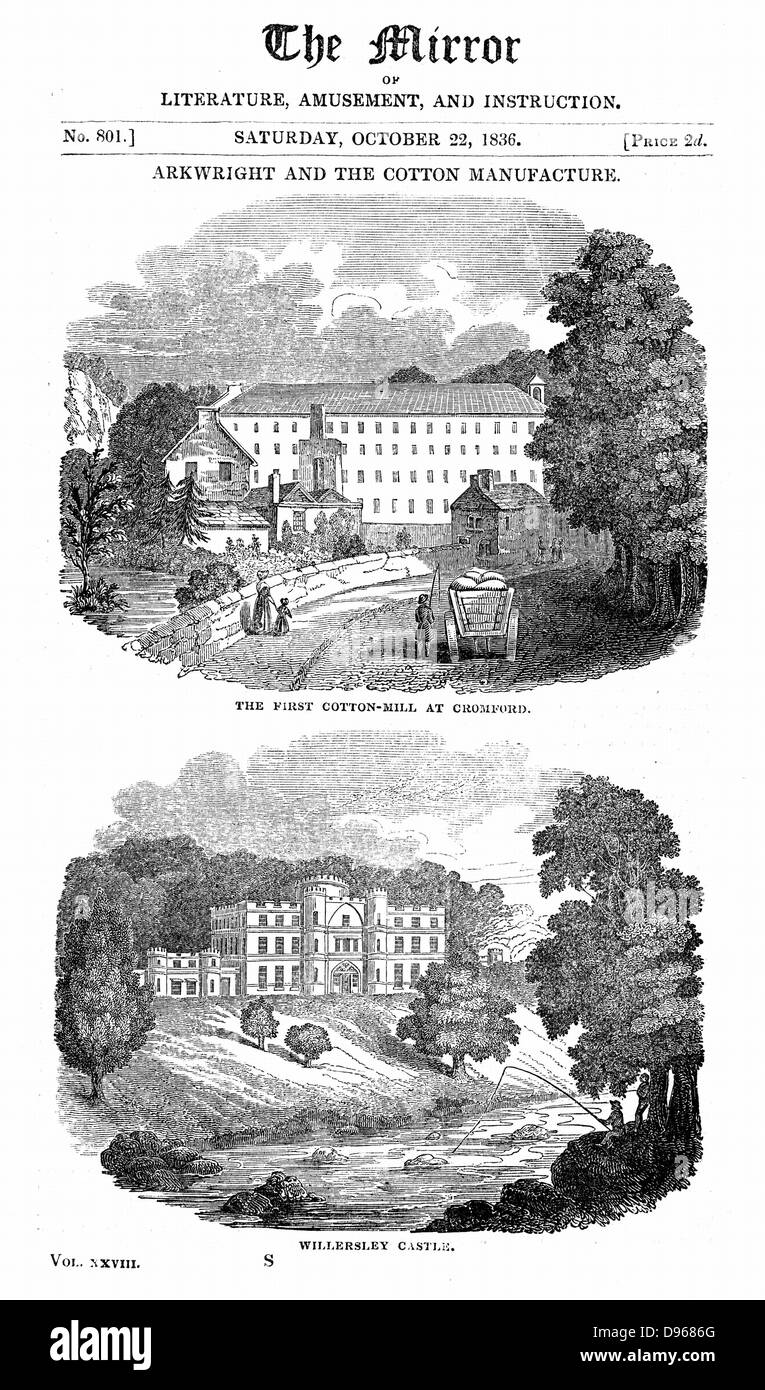 Richard Arkwright (1732-1792). British industrialist and inventor. Water-powered spinning frame. Top: Cotton mill at Cromford, Wirksworth, Derbyshire which Arkwright fitted with his water frame. Bottom: Willersley Castle, the house Arkwright built for him Stock Photohttps://www.alamy.com/image-license-details/?v=1https://www.alamy.com/stock-photo-richard-arkwright-1732-1792-british-industrialist-and-inventor-water-57301176.html
Richard Arkwright (1732-1792). British industrialist and inventor. Water-powered spinning frame. Top: Cotton mill at Cromford, Wirksworth, Derbyshire which Arkwright fitted with his water frame. Bottom: Willersley Castle, the house Arkwright built for him Stock Photohttps://www.alamy.com/image-license-details/?v=1https://www.alamy.com/stock-photo-richard-arkwright-1732-1792-british-industrialist-and-inventor-water-57301176.htmlRMD9686G–Richard Arkwright (1732-1792). British industrialist and inventor. Water-powered spinning frame. Top: Cotton mill at Cromford, Wirksworth, Derbyshire which Arkwright fitted with his water frame. Bottom: Willersley Castle, the house Arkwright built for him
 Richard Arkwright (1732-1792). Inventing the spinning frame. Engraving. Nuestro Siglo, 1883. Spanish edition. Color. Stock Photohttps://www.alamy.com/image-license-details/?v=1https://www.alamy.com/stock-photo-richard-arkwright-1732-1792-inventing-the-spinning-frame-engraving-137765048.html
Richard Arkwright (1732-1792). Inventing the spinning frame. Engraving. Nuestro Siglo, 1883. Spanish edition. Color. Stock Photohttps://www.alamy.com/image-license-details/?v=1https://www.alamy.com/stock-photo-richard-arkwright-1732-1792-inventing-the-spinning-frame-engraving-137765048.htmlRMJ03MM8–Richard Arkwright (1732-1792). Inventing the spinning frame. Engraving. Nuestro Siglo, 1883. Spanish edition. Color.
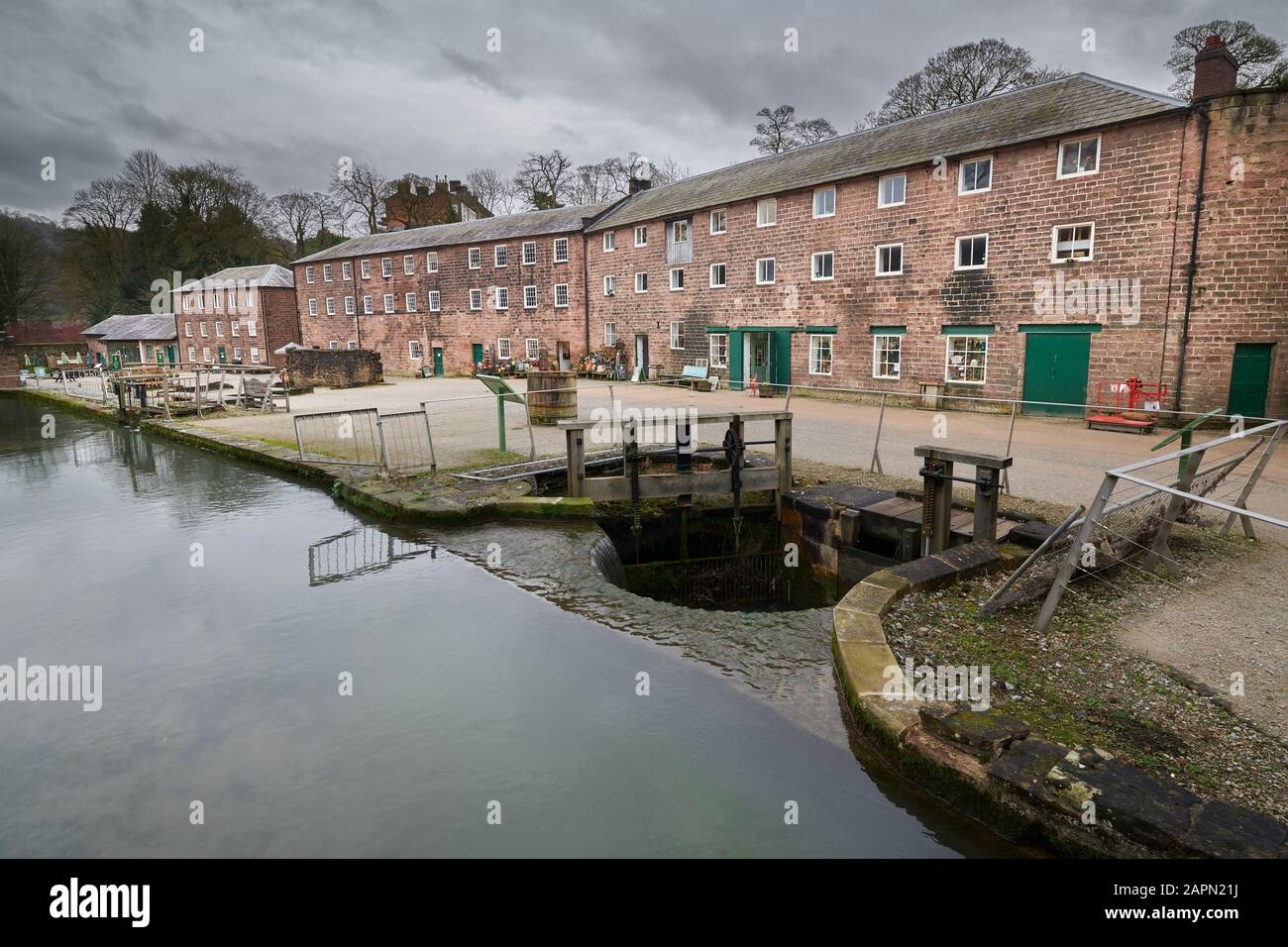 Cromford cotton spinning water powered mills, Sir Richard Arkwright’s first mill complex, birthplace of the factory system, and a UNESCO World Heritag Stock Photohttps://www.alamy.com/image-license-details/?v=1https://www.alamy.com/cromford-cotton-spinning-water-powered-mills-sir-richard-arkwrights-first-mill-complex-birthplace-of-the-factory-system-and-a-unesco-world-heritag-image340982030.html
Cromford cotton spinning water powered mills, Sir Richard Arkwright’s first mill complex, birthplace of the factory system, and a UNESCO World Heritag Stock Photohttps://www.alamy.com/image-license-details/?v=1https://www.alamy.com/cromford-cotton-spinning-water-powered-mills-sir-richard-arkwrights-first-mill-complex-birthplace-of-the-factory-system-and-a-unesco-world-heritag-image340982030.htmlRF2APN21J–Cromford cotton spinning water powered mills, Sir Richard Arkwright’s first mill complex, birthplace of the factory system, and a UNESCO World Heritag
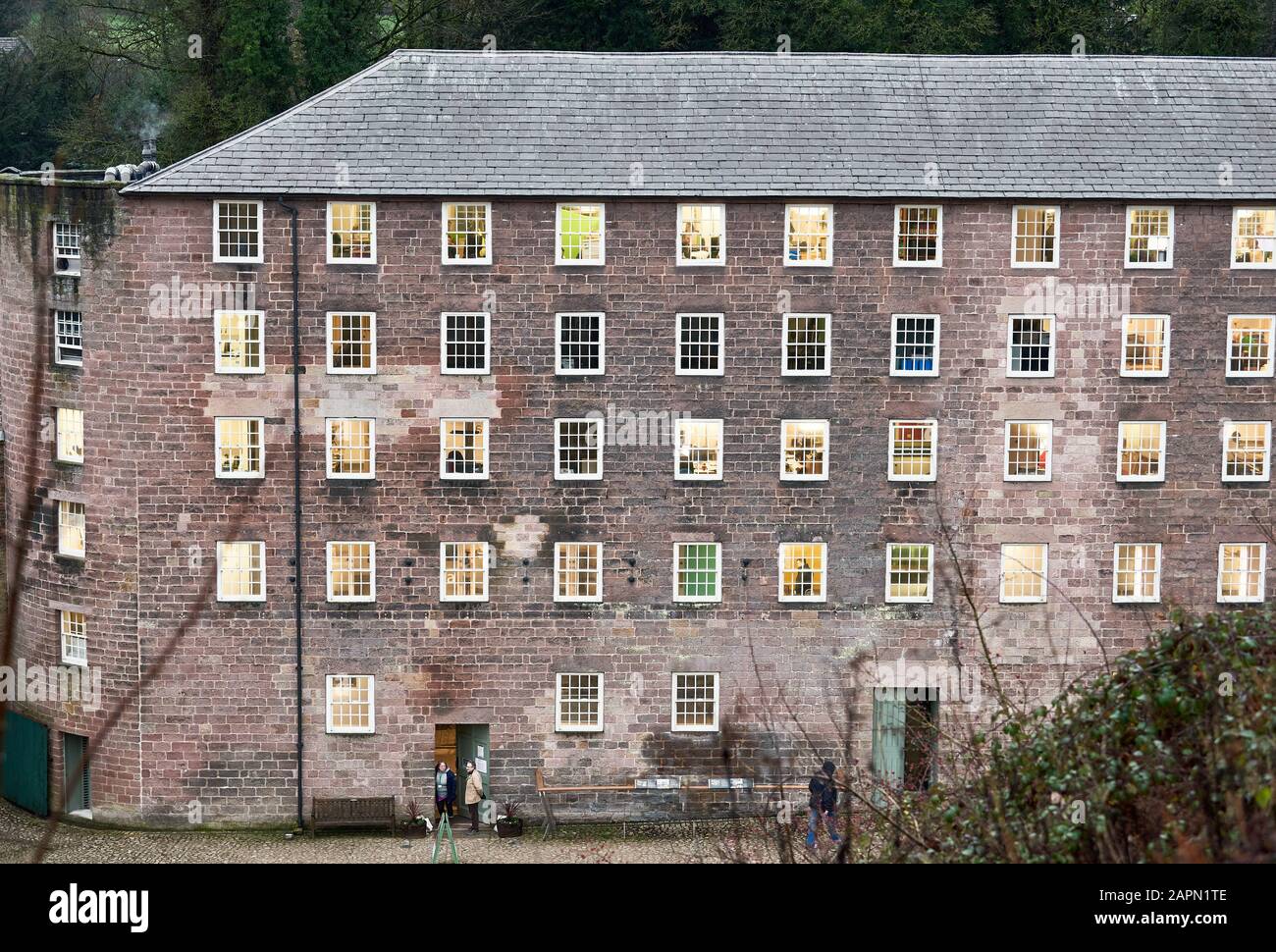 Cromford cotton spinning water powered mills, Sir Richard Arkwright’s first mill complex, birthplace of the factory system, and a UNESCO World Heritag Stock Photohttps://www.alamy.com/image-license-details/?v=1https://www.alamy.com/cromford-cotton-spinning-water-powered-mills-sir-richard-arkwrights-first-mill-complex-birthplace-of-the-factory-system-and-a-unesco-world-heritag-image340981886.html
Cromford cotton spinning water powered mills, Sir Richard Arkwright’s first mill complex, birthplace of the factory system, and a UNESCO World Heritag Stock Photohttps://www.alamy.com/image-license-details/?v=1https://www.alamy.com/cromford-cotton-spinning-water-powered-mills-sir-richard-arkwrights-first-mill-complex-birthplace-of-the-factory-system-and-a-unesco-world-heritag-image340981886.htmlRF2APN1TE–Cromford cotton spinning water powered mills, Sir Richard Arkwright’s first mill complex, birthplace of the factory system, and a UNESCO World Heritag
 Blue plaque marking the occupancy by Arkwright in Adam Street, London Stock Photohttps://www.alamy.com/image-license-details/?v=1https://www.alamy.com/blue-plaque-marking-the-occupancy-by-arkwright-in-adam-street-london-image468287650.html
Blue plaque marking the occupancy by Arkwright in Adam Street, London Stock Photohttps://www.alamy.com/image-license-details/?v=1https://www.alamy.com/blue-plaque-marking-the-occupancy-by-arkwright-in-adam-street-london-image468287650.htmlRM2J5T9JX–Blue plaque marking the occupancy by Arkwright in Adam Street, London
 Richard Arkwright (1732-1792), English inventor and industrialist, born at Preston in Lancashire. Inventor in 1769 of the spinning frame (water frame). In 1771, in partnership with Jeddiah Strutt, he built the first water-powered cotton mill at Cromford, Derbyshire. His innovations contributed significantly to the Industrial Revolution and he died one of the richest men in England. Engraving after the portrait by Joseph Wright of Derby. From 'The Gallery of Portraits', Vol V, by Charles Knight (London, 1835). Stock Photohttps://www.alamy.com/image-license-details/?v=1https://www.alamy.com/stock-photo-richard-arkwright-1732-1792-english-inventor-and-industrialist-born-57287095.html
Richard Arkwright (1732-1792), English inventor and industrialist, born at Preston in Lancashire. Inventor in 1769 of the spinning frame (water frame). In 1771, in partnership with Jeddiah Strutt, he built the first water-powered cotton mill at Cromford, Derbyshire. His innovations contributed significantly to the Industrial Revolution and he died one of the richest men in England. Engraving after the portrait by Joseph Wright of Derby. From 'The Gallery of Portraits', Vol V, by Charles Knight (London, 1835). Stock Photohttps://www.alamy.com/image-license-details/?v=1https://www.alamy.com/stock-photo-richard-arkwright-1732-1792-english-inventor-and-industrialist-born-57287095.htmlRMD95J7K–Richard Arkwright (1732-1792), English inventor and industrialist, born at Preston in Lancashire. Inventor in 1769 of the spinning frame (water frame). In 1771, in partnership with Jeddiah Strutt, he built the first water-powered cotton mill at Cromford, Derbyshire. His innovations contributed significantly to the Industrial Revolution and he died one of the richest men in England. Engraving after the portrait by Joseph Wright of Derby. From 'The Gallery of Portraits', Vol V, by Charles Knight (London, 1835).
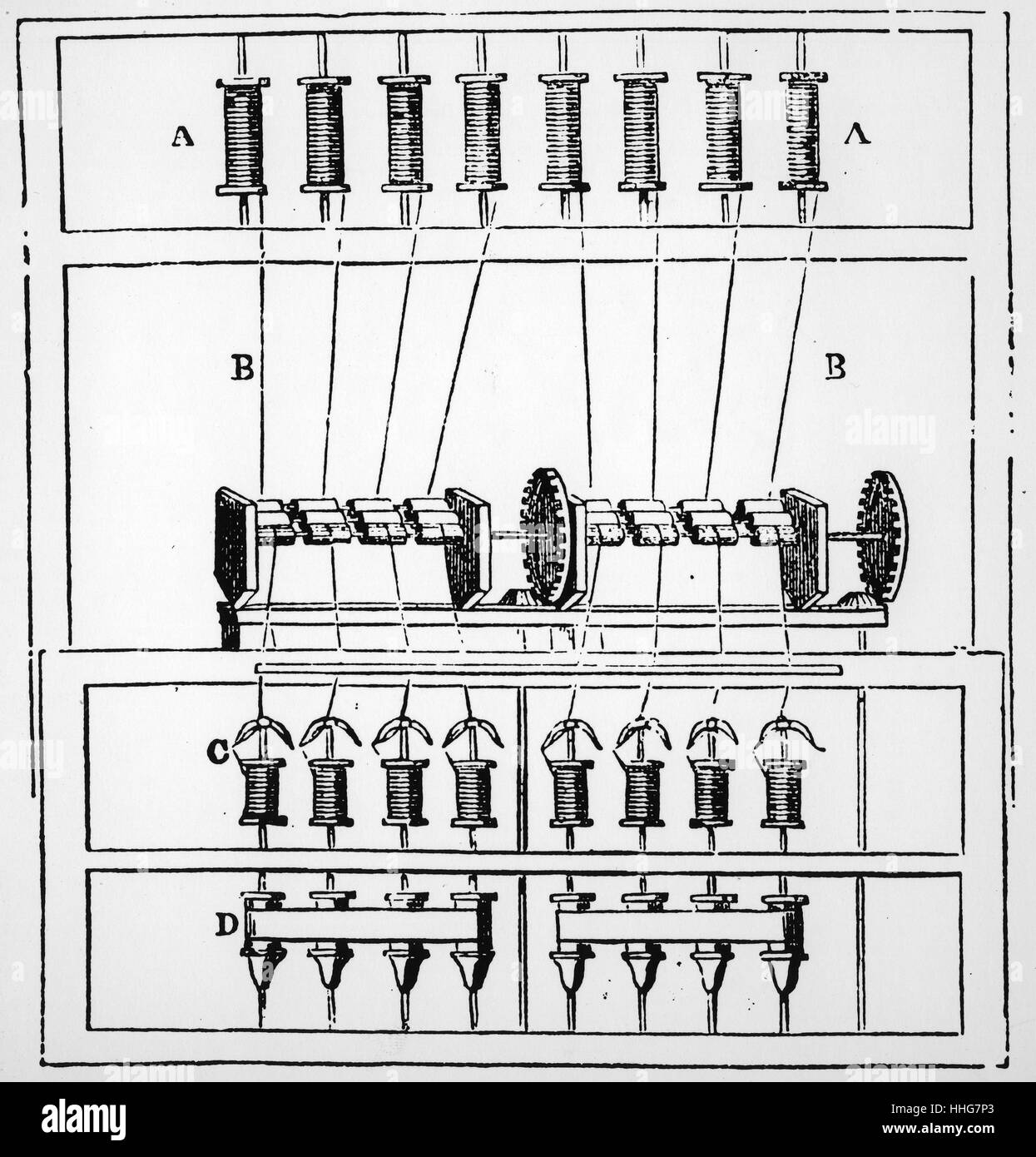 Diagram of Arkwright's water frame, 1878. The water frame is the name given to a water-powered spinning frame which was an easy way to create cotton thread. The first time the machine was used in 1768. It was able to spin 128 threads at a time, which was the easiest and fastest method than ever before. It was developed by Richard Arkwright, who patented the technology in 1767 Stock Photohttps://www.alamy.com/image-license-details/?v=1https://www.alamy.com/stock-photo-diagram-of-arkwrights-water-frame-1878-the-water-frame-is-the-name-131279067.html
Diagram of Arkwright's water frame, 1878. The water frame is the name given to a water-powered spinning frame which was an easy way to create cotton thread. The first time the machine was used in 1768. It was able to spin 128 threads at a time, which was the easiest and fastest method than ever before. It was developed by Richard Arkwright, who patented the technology in 1767 Stock Photohttps://www.alamy.com/image-license-details/?v=1https://www.alamy.com/stock-photo-diagram-of-arkwrights-water-frame-1878-the-water-frame-is-the-name-131279067.htmlRMHHG7P3–Diagram of Arkwright's water frame, 1878. The water frame is the name given to a water-powered spinning frame which was an easy way to create cotton thread. The first time the machine was used in 1768. It was able to spin 128 threads at a time, which was the easiest and fastest method than ever before. It was developed by Richard Arkwright, who patented the technology in 1767
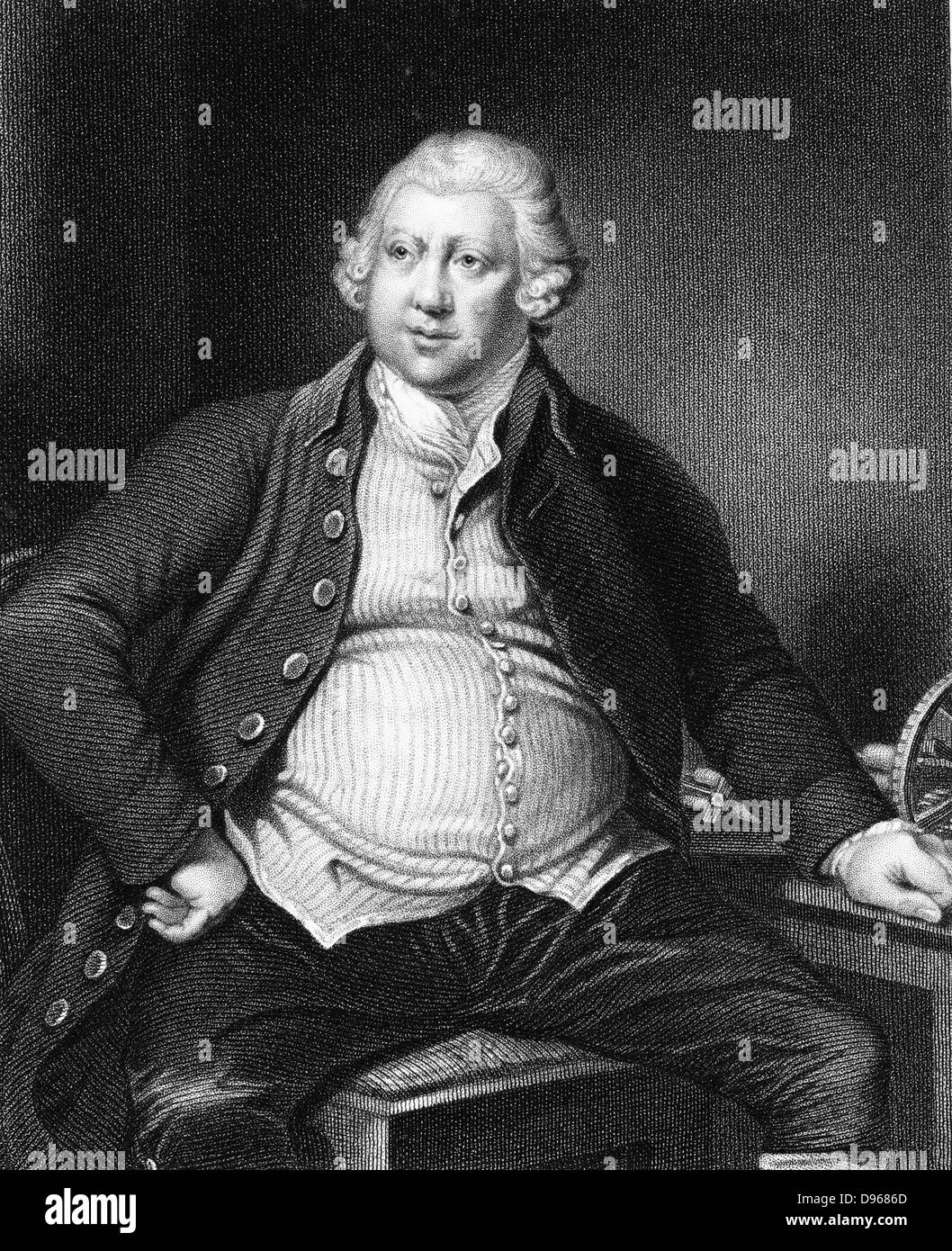 Richard Arkwright (1732-1792) British industrialist and inventor: Water-powered spinning frame. Engraving after portrait by Joseph Wright of Derby. Stock Photohttps://www.alamy.com/image-license-details/?v=1https://www.alamy.com/stock-photo-richard-arkwright-1732-1792-british-industrialist-and-inventor-water-57301173.html
Richard Arkwright (1732-1792) British industrialist and inventor: Water-powered spinning frame. Engraving after portrait by Joseph Wright of Derby. Stock Photohttps://www.alamy.com/image-license-details/?v=1https://www.alamy.com/stock-photo-richard-arkwright-1732-1792-british-industrialist-and-inventor-water-57301173.htmlRMD9686D–Richard Arkwright (1732-1792) British industrialist and inventor: Water-powered spinning frame. Engraving after portrait by Joseph Wright of Derby.
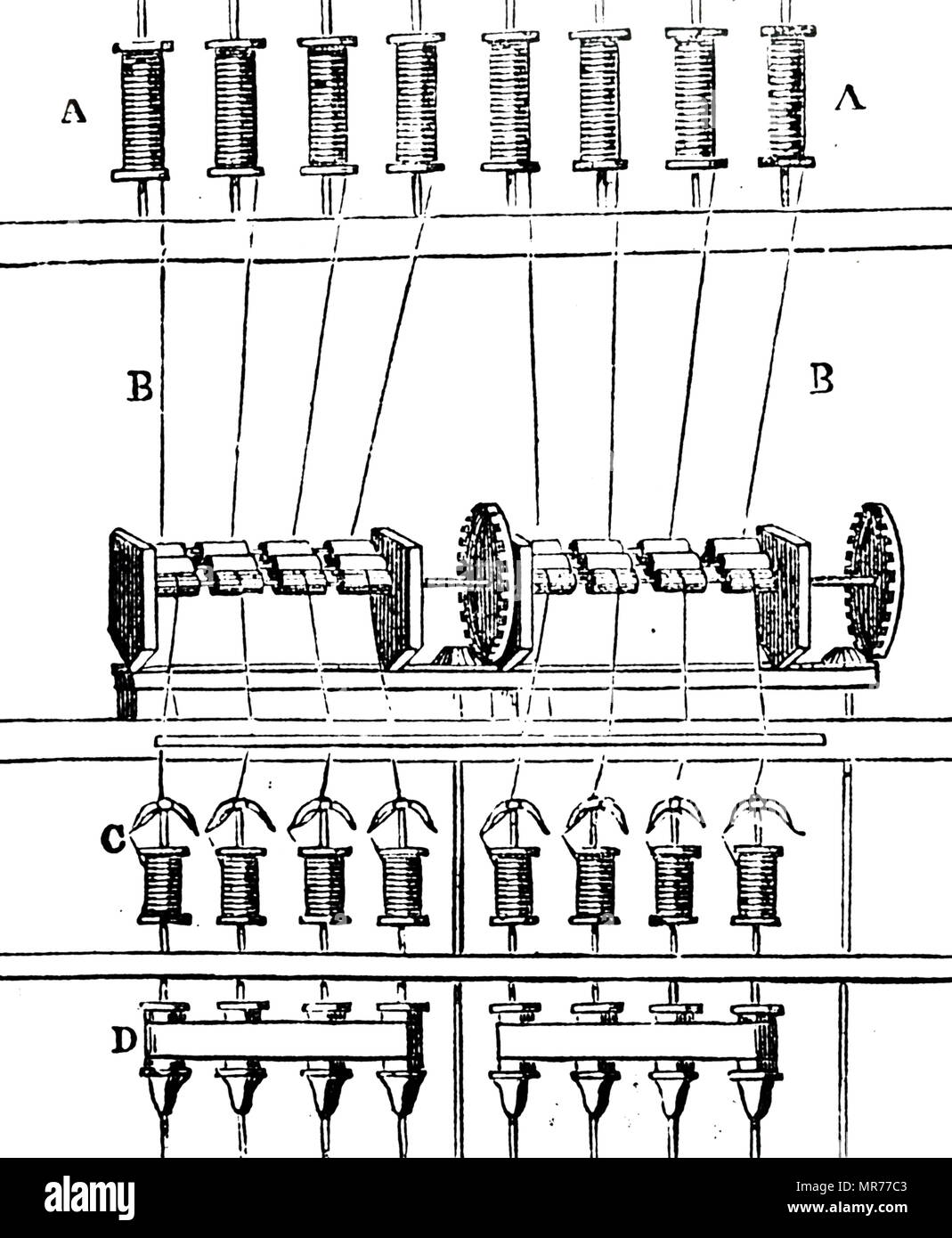 Engraving depicting a diagram Richard Arkwright's water frame. Richard Arkwright (1732-1792) an English inventor and a leading entrepreneur during the early Industrial Revolution. Dated 19th century Stock Photohttps://www.alamy.com/image-license-details/?v=1https://www.alamy.com/engraving-depicting-a-diagram-richard-arkwrights-water-frame-richard-arkwright-1732-1792-an-english-inventor-and-a-leading-entrepreneur-during-the-early-industrial-revolution-dated-19th-century-image186400259.html
Engraving depicting a diagram Richard Arkwright's water frame. Richard Arkwright (1732-1792) an English inventor and a leading entrepreneur during the early Industrial Revolution. Dated 19th century Stock Photohttps://www.alamy.com/image-license-details/?v=1https://www.alamy.com/engraving-depicting-a-diagram-richard-arkwrights-water-frame-richard-arkwright-1732-1792-an-english-inventor-and-a-leading-entrepreneur-during-the-early-industrial-revolution-dated-19th-century-image186400259.htmlRMMR77C3–Engraving depicting a diagram Richard Arkwright's water frame. Richard Arkwright (1732-1792) an English inventor and a leading entrepreneur during the early Industrial Revolution. Dated 19th century
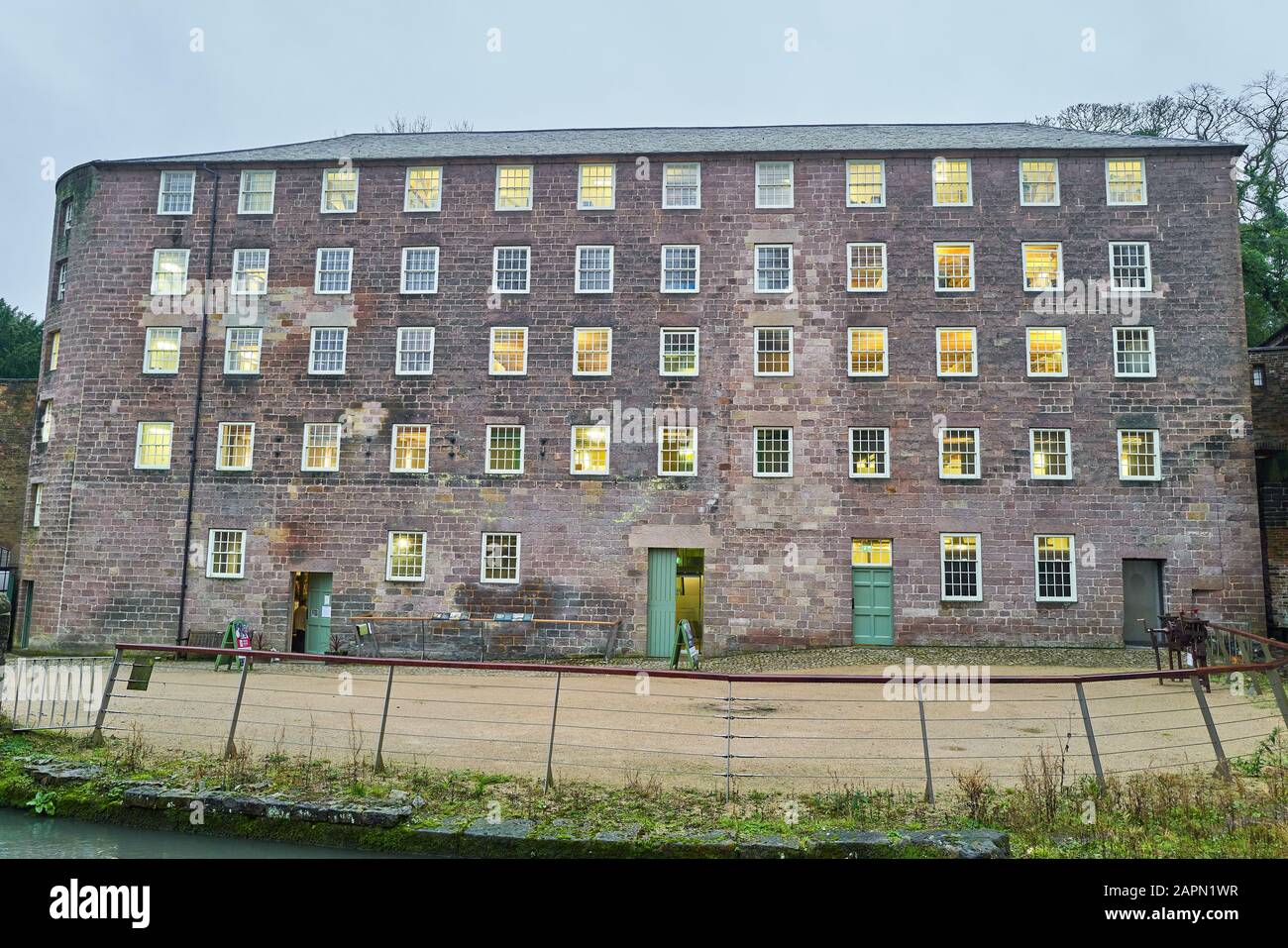 Cromford cotton spinning water powered mills, Sir Richard Arkwright’s first mill complex, birthplace of the factory system, and a UNESCO World Heritag Stock Photohttps://www.alamy.com/image-license-details/?v=1https://www.alamy.com/cromford-cotton-spinning-water-powered-mills-sir-richard-arkwrights-first-mill-complex-birthplace-of-the-factory-system-and-a-unesco-world-heritag-image340981923.html
Cromford cotton spinning water powered mills, Sir Richard Arkwright’s first mill complex, birthplace of the factory system, and a UNESCO World Heritag Stock Photohttps://www.alamy.com/image-license-details/?v=1https://www.alamy.com/cromford-cotton-spinning-water-powered-mills-sir-richard-arkwrights-first-mill-complex-birthplace-of-the-factory-system-and-a-unesco-world-heritag-image340981923.htmlRF2APN1WR–Cromford cotton spinning water powered mills, Sir Richard Arkwright’s first mill complex, birthplace of the factory system, and a UNESCO World Heritag
 Blue plaque marking the occupancy by Arkwright in Adam Street, London Stock Photohttps://www.alamy.com/image-license-details/?v=1https://www.alamy.com/blue-plaque-marking-the-occupancy-by-arkwright-in-adam-street-london-image468287648.html
Blue plaque marking the occupancy by Arkwright in Adam Street, London Stock Photohttps://www.alamy.com/image-license-details/?v=1https://www.alamy.com/blue-plaque-marking-the-occupancy-by-arkwright-in-adam-street-london-image468287648.htmlRM2J5T9JT–Blue plaque marking the occupancy by Arkwright in Adam Street, London